Posts Tagged ‘USHMM’
Thursday, July 7th, 2016
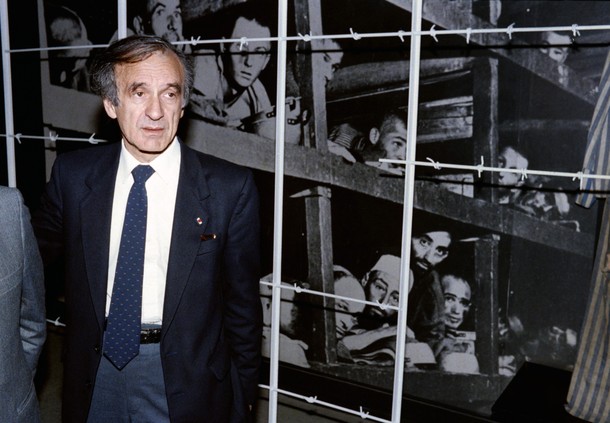
1986 Nobel Peace prize winner and writer Elie Wiesel (L) stands in front of a photo he claimed to be himself (bottom right hand corner) with other inmates, taken at the Buchenwald concentration camp in 1945, during his post-Nobel visit on December 18, 1986 to the Holocaust Memorial Center “Yad Vashem” in Jerusalem. SVEN NACKSTRAND/AFP/Getty Images)
BY CAROLYN YEAGER
The French website Enquete & Debat (E&D) has been on to Elie Wiesel’s failure to answer questions about his “missing” tattoo since 2012. The Jewish or part-Jewish chief of E&D is Jean Robin, and he is the one who has taken it upon himself, the past four years, to investigate what he calls the Elie Wiesel Affair. Robin has explained his position in this way: “I am also interested in these matters since a part of my jewish family on my mothers side died in Auschwitz, and a great grand father on my father side, Noël Robin, was deported to Buchenwald and died in Dora for resisting the nazis.” [For being active in the French Resistance, he means, just like Paul Rassinier who later turned into a revisionist. -cy]
Elie Wiesel Cons The World premiered on July 13, 2010. Enquete & Debat was established on June 18, 2010, but did not turn its attention to Elie Wiesel until Dec. 24, 2012, two and one-half years later. The first article based it’s information on Nicholas Grüner’s book Stolen Identity, Robin said. He wrote in that first article that they learned about Grüner from the American ‘Brother Nathanael’ (via Alain Sorel, the French négationniste), but Nathanael got most of his information from Elie Wiesel Cons The World. E&D has used an image that was created especially for EWCTW, so I know he is a follower of this site. Robin is careful not to give attention to it, though; he called me an “authentic nazi.”
M. Robin has done a beneficial service, which is much appreciated, by writing and phoning archivists at the Auschwitz-Birkenau state Museum in Oświęcim, Poland and the Elie Wiesel Foundation for Humanity in Romania, seeking information about Wiesel’s missing tattoo. The head person at the latter premises hung up on him when she learned the object of his call. He has made all of this public.
Unlike me, Jean Robin appears to be truly heartbroken over what he has discovered. He believes in the six million! He has written that he and Nicholas Grüner have repeatedly contacted news media and important figures within the Holocaust establishment with their information, imploring them to publicly question Wiesel, but got only insults or wishy-washy excuses in return. He believes that Wiesel’s forgery damages the Shoah story, and cannot understand why Wiesel is more important to these people than the entire Shoah. I don’t think he suspects, as I believe, that many of them already know the entire ‘Holocaust’ is a lie, but keep it up for the political power it gives them, or fear of that power. In his statement on Wiesel’s death (below), you can notice a tinge of bitterness mixed with the disappointment.
Elie Wiesel died before he confessed his lies about the Holocaust
Elie Wiesel, who lied about his identity, his Auschwitz tattoo that he does not have, and his imaginary detention in Buchenwald, as we have shown, has died. All media will praise a forger of history, whose lies have allowed deniers to create doubt about the Holocaust itself.
On this occasion, we have linked to all the articles we devoted to this infamous character [nine in all -cy], who is an enemy of the Jewish people and of Israel by his lies, his glory totally undeserved.
In my first article of 24 December 2012 [English version here], I wrote: “I am calling on the Jewish community throughout the world, personalities who are concerned about the Holocaust and the future of its memory, as well as major media to take responsibility and compel [Elie Wiesel] to answer the serious questions raised about him. This must be done while MM. Wiesel and Grüner, the two persons mainly concerned in this case, are by chance still alive, but unfortunately won’t be much longer because of their age (they are both over 80 years).” Alas, it is now too late, nobody took responsibility for Mr. Wiesel.
Jean Robin
M. Robin understands, because he uses logic and reasoning, not emotion and fear, that there is no redeeming the Shoah witness Elie Wiesel now. He has died a liar. As the icon’s friends pass away too, will there be anyone to defend him? The United States Holocaust Museum in Washington D.C. must be very undecided as to how to handle their founding chairman from here on. There is no doubt he did not have the tattoo on his arm – never had it. There is also no doubt that the “important Holocaust figures”–what I’ve been calling the Holocaust Lobby–were unwilling to allow the question to be asked. Indeed, and in fact, they joined in the lying (such as claiming Wiesel to be in the famous Buchenwald liberation photo) to help him get a Nobel Peace Prize. The top media liar would be the New York Times, followed by the Associated Press (AP), NBC and PBS, but all the rest went along too. While M. Robin will not consider the Holocaust-Shoah to be a hoax, he knows that “l’affaire Wiesel” is a hoax and that puts everyone who went along with it into question, whether he wants that or not.
12 Comments
Category Featured | Tags: Tags: Auschwitz tattoos, Elie Wiesel Cons The World, Enquete & Debat, Jean Robin, New York Times, Nicholas Gruner, USHMM,
Social Networks: Facebook, Twitter, Google Bookmarks, del.icio.us, StumbleUpon, Digg, Reddit, Posterous.
Sunday, April 17th, 2016
BY CAROLYN YEAGER
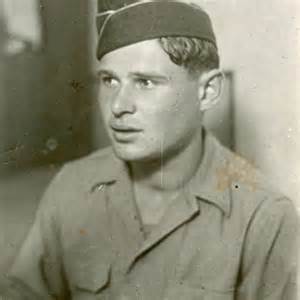
This is a picture of Paul Argiewicz used by the Wisconsin Veterans Museum but with no description. Considering he’s wearing a US Army cap it has to be from after 1950, which would make him over 25 years of age.
Remember Paul Argiewicz? He’s the guy I wrote about here because it’s widely claimed he’s in the Famous Buchenwald Liberation Photo, which he is not. But there are a lot of things wrong with the Paul Argiewicz story – claiming he is in that photo is just one of them.
Christine Miller has observed that being forced to believe holocaust survivor’s stories has made Western man irrational. Paul’s story is as irrational as any, especially when it comes to the simple act of adding together two-digit numbers. So let’s start there.
Paul’s date of birth is always given as Aug. 6, 1925 in Bielsko, Poland. He grew up using his mother’s name, Argiewicz, because his parents were not formally or officially married. The family included two older sisters. He told interviewers that he only went three and a half years to grade school. He was arrested in 1941 by his own reckoning, when he would have been 16 years old.
However, his story, wherever you look either online or in the book about him, states that he was age 11 at the time of his arrest by the Nazis, and in his own obituary written or approved by his family it says “he was arrested at age 10 by the SS for stealing bread for his starving family in the Jewish ghetto.” [The ‘stealing bread for starving family’ part is obviously fiction, but Paul was known as an emotional person who cried easily and liked to create as much sympathetic reaction in his listeners as possible.]
So what’s going on with this man? And with his family and biographer? Can’t they add? It’s apparent that holocaust survivors have become so complacent because of their experience that anything they say will pass that they actually believe “anything will pass.” Even to the point that if you’re born in 1925 you can be 11 years old in 1941. Think about it. The year of Paul’s arrest is not always mentioned as it is here, but we all know the camps were liberated in 1945, and we know he turned 20 in that year. Precisely, he was 19 on April 11, 1945, four months shy of his 20th birthday … not 14.
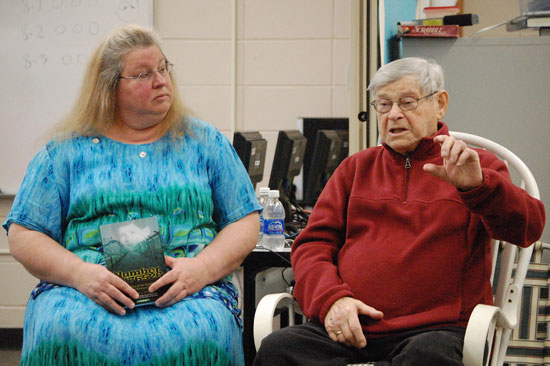
Deanne Joseph Ebner (left) who wrote the book “Number 176520: The Story of Paul Argiewicz ”A Teenage Holocaust Survivor” appeared with Argiewicz in 2012 at Riverview School.
What makes this age imposture important enough for Paul and his biographer to try to slip it past most readers? The craving for attention. Paul separates himself from the crowded field of fellow “survivors” by billing himself as a “child survivor.” He describes himself as being still a teenager when he was released … which he was, even if just barely. But he wanted to be younger still … a child. And what is surprising is that he basically has gotten away with it! I have not come across anyone questioning the claim that Paul was 11 when he was arrested, even though he was born in 1925. [I notice he told the Wisconsin Veterans Museum interviewer on page 7 that he was born in 1933!]
This type of “pass” can be better understood from a question by a poster commenting to another “survivor” who claimed he rode in a packed train car for 6 days with no food or water and no stops:
Did anyone die midway in the six day train ride with no food/water? I’m by no means doubting, just asking a question. As someone has mentioned below, you CAN survive without water for about a week.
God forbid these young people should doubt anything said by a holy survivor, no matter how unconnected to reality. The “survivor” answered he didn’t recall any deaths. But the point being, we don’t ask questions – we’re ashamed or afraid to question – and it leads to utter nonsense.
After doing more than a bit of research into Paul Argiewicz, I’ve come to the conclusion that there is also a felt need by him to gain as much sympathy as possible from being a tender 11 years of age to avoid what may be legitimate questions about what he actually did during that 4-5 years in German camps. I’m quite sure that Paul was never starved nor even mistreated during his time in the camps. He was more likely quite the collaborator. The photo on his German drivers license dated June 1946, only one year after liberation, shows a healthy young man with no sign of having endured any trauma whatsoever. He’s wearing an expensive leather jacket or coat and looks untroubled and at peace with himself.
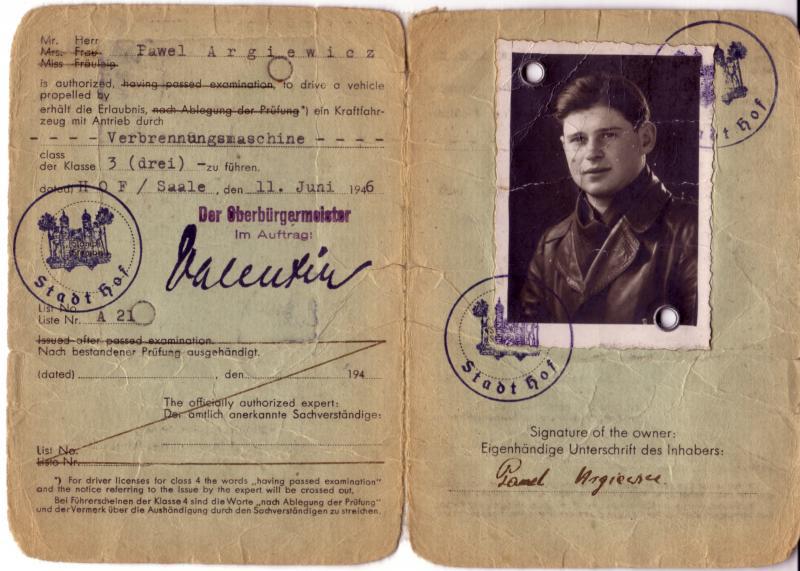
German Drivers License issued to Paul Angiewicz in June 1946. He was obviously living in Germany at the time and looking prosperous.
The same craving for attention also accounts for his willingness to falsely identify himself in the Famous Buchenwald Liberation Photo. Argiewicz named himself as the person 3rd from the left in the 3rd bunk up from the bottom in 2008, the same year his book came out. Everyone in that photo is self-identified, and it began after Elie Wiesel identified himself in it in 1983. Before that, no one was identified. After research by a number of people, including myself, it turns out the only correctly identified person is 16-year old Michael (Nikolaus) Grüner in the lower left. Even Argiewicz’ nephew, Murray Matzner, says his uncle is not in the picture, but excuses his uncle’s lies with the charge that he was under the influence of the woman who wrote the book about him, Deanne I. Joseph. Matzner wrote a comment at Scrapbookpages Blog in 2015 to a post that originally appeared in 2010.
It is obvious that my uncle Paul Argiewicz is not the person indicated in the photo. It looks nothing like him, and is in fact proved not to be him in his own memoir book photo on the opposite page where a drivers license photo one year later does not resemble this face at all. In particular, he did not have eyebrows that curved so far around his eyes.
The assertion that he is present in this photo was nonexistent until 2008, the year his memoir book was published. Since his ghost written book gets so very many facts and stories wrong, as the website associated with book sales also does, and stains a courageous man of integrity who is greatly missed because he is no longer with us, it appears that the false assertion is associated with the factually compromised book.
I have also seen a photo where it is the man one bunk lower, and to the left, a sleeping man facing away from the camera, who is indicated as my uncle with a vertical arrow.
I don’t know what it is with this photo. The individual indicated as Mr. Wiesel appears to have a receding hairline although a published image of him at age 15 prior to deportation does not have such a hairline. I believe that neither he or my uncle appear in the photo, and it appears to me that at least in the case of my uncle, that it was someone else pushing for him to be present.
My uncle was a wonderful, warm, caring, courageous, person who inspired so many with his exceptional love of life and people… but he isn’t in this photograph.
RIP, uncle. Your love lives on.
Comment by Murray Matzner — April 3, 2015 @ 1:03 pm
Okay Murray, except that Paul was photographed at one of his gatherings holding an enlargement of the famous photograph, indicating that he certainly wanted people to believe that he was in the picture. He, and maybe more so his wife Sheryl have been fully engaged in that fantasy.
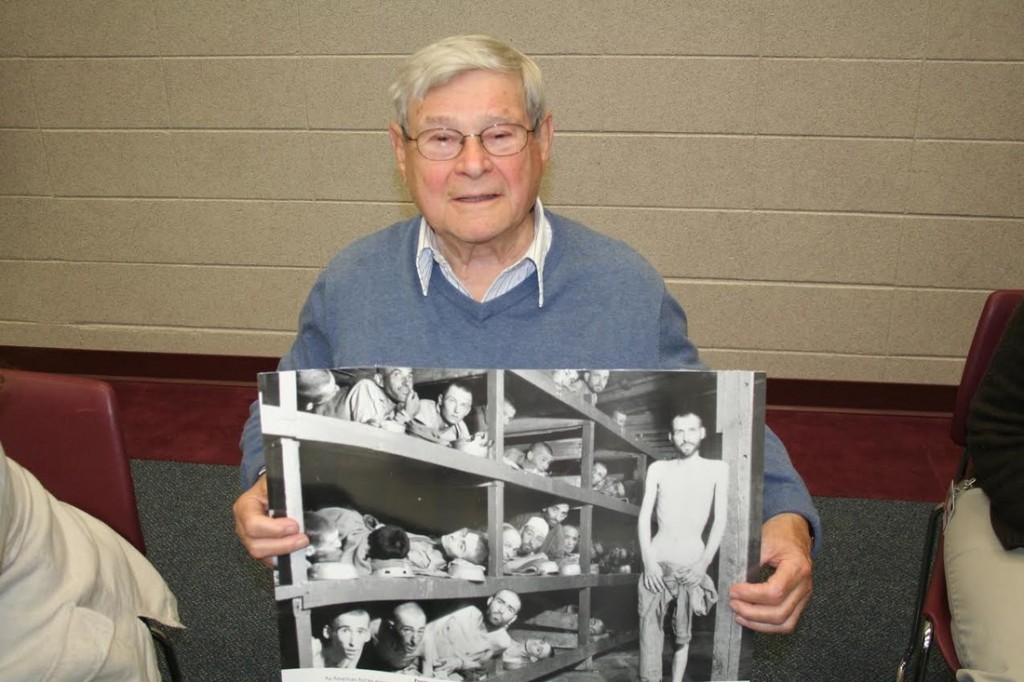
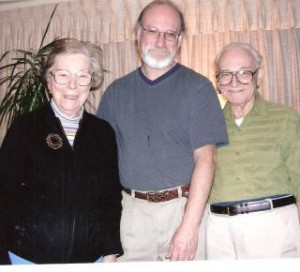
Lucy Argiewicz Matzner (Paul’s “beloved” sister), her son Murray and husband Robert.
Murray’s father, Robert Matzner, (left, in green shirt) who married Paul’s sister Lucy, was born in 1926 in the same Polish town of Bielsko. He has written his own holocaust memoir, titled Prisoner 19053. I wonder how many falsehoods that book contains? Hopefully not as many as Paul’s. But I think Murray may be trying to keep peace in the family by blaming the falsehoods in Paul’s book on the author. Clearly, Paul’s wife Sheryl had a lot to do with the writing of the book, and the three are often pictured attending book-promotion meetings together.
* * *
After Paul’s death in December 2013, some controversy broke out on the Amazon book advertisement page among the “reviewers.” Specifically “BTI” wrote:
In Memory of Paul
By BTI on June 22, 2015
Every story in this book is documented in numerous recordings, CDs, and videos as coming from Paul Argiewicz himself – his face, his words, his voice. It is Paul’s account of what happened to him as a young boy in the Nazi concentration camps. Anyone who knew Paul, loved Paul, was inspired by Paul, and truly desires to protect the memory of Paul Argiewicz will boldly stand witness against the frauds of the world (be they Holocaust deniers, anti-Semites, or vindictive relatives). All of the above-mentioned records of Paul’s testimony will soon be posted online. Be watching. May the evil ones be silenced by their own arrogance.
Cindy Nicoletti, Paul’s stepdaughter, posted a “review” by Dave Kasiske. In it he revealed:
“I am blown away that Paul’s nephew would come out now after Paul’s death. He cannot say the man in the picture is not Paul because the poor young Paul was probably close to death after experiencing starvation. Paul would say “Dave”, I can’t explain it to you how it was to cry at night because of starvation and never seeing my loved ones again.”
And
“Paul was always in tears when he told the story of his sister Lucy. Lucy is the mother of “Murray”, the one who is attacking Paul’s story. That brings the question to my mind, why would anyone who is Jewish go on a antisemitic spur? Even when I would sit with Paul at his kitchen table, the tears would flow when he talked about Lucy. Anyone who has the guts to attack a family member who survived the horrors of the Holocaust should seek psychological help.”
Yes, it takes guts indeed to stand up against holocaust lies, Dave. Maybe someday you’ll be able to do it. But now take a look at this from stepdaughter Cindy to see who is pushing Paul’s false story.
The owner of Sunless Expressions would like to recommend her stepfather’s book:
Number 176520
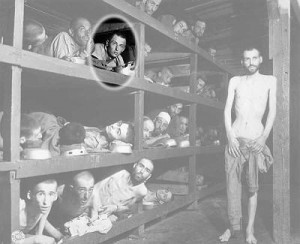
This famous photograph was taken a few days after the liberation of Buchenwald and appeared on the cover of a popular national magazine in the 1960s. Paul is pictured (circled) here on the third bunk from the bottom, the third person from the left (with his food bowl that doubled as a pillow).
Cindy, Owner and Founder of Sunless Expressions is the step daughter of a man with an astounding and miraculous life story. Paul Argiewicz was an eleven year old child in 1941 when he was arrested in Poland by two Nazi SS officers. His crime? Paul had stolen two loaves of bread to take to his starving family in the Jewish ghetto. Separated from his family and everything he loved, he would spend the next four years of his young life working as a slave laborer in seven different concentration camps. From Auschwitz to Blechhammer, Gross Rosen, and Buchenwald, Argiewicz; defied all odds by surviving one of modern history’s most unimaginable atrocities against humanity: the Holocaust.
Sunless Expressions is proud to recommend Number 176520 ~ The Story of Paul Argiewicz, a Teenage Holocaust Survivor. With over 16 pages of full-color photos, original camp documents, and other visuals, Number 176520 has quickly become a highly revered and sought-after Holocaust resource in schools, bookstores, libraries, museums, and homes. Visit www.paulsstory.com to purchase and/or learn more about the book that has been inspiring countless readers around the world.
We regretfully announce Paul passed away December 11, 2013.
Paul’s last public appearance before his death was on April 29, 2013 at the U.S. Holocaust Museum’s 20th Anniversary Ceremony with speakers Elie Wiesel and Bill Clinton. Here he is photographed with his wife Sheryl and grandson Jordan, who are active in furthering the mythical version of his life. In another photo he is showing off his Auschwitz tattoo “176520,” as they were all doing that night (except for Wiesel, of course). Yes, they were there, but what they did or did not experience cannot be proven by a tattoo.
There are no excerpts available from his book at Amazon, but I found this one and am going to quote it in full here. It gives a good idea of the fictional style found in most holocaust survivor stories – no dates, times, names – the events, as they are, exist as if floating in space, but are meant to evoke as much emotional sympathy, shock and pity as possible toward the subject. Notice the similarities to Elie Wiesel’s Night, which must have been used as a model, for example when the fellow arrestee advises a confused Paul to say he is 18. However, Paul’s “ghostwriter” handled the impossible jump from age 11 to age 18 by having the SS man play it as a sort of joke. And since Paul says he spoke perfect German, that warmed the heart of the otherwise cold officer. The whole scene is a lie …
At Scrapbookpages Blog, the blogger wrote in March 2010: “Argiewicz says that he had an advantage because he could speak fluent German since his mother was from Bavaria, a state in Germany.” Of course, we know his mother and father were both Polish, and Ms. Joseph comes up with a different story: That Paul associated with Gentile youths when he snuck out of the ghetto every other night for a year (!) and learned German that way. But weren’t there Poles along with Germans outside of the ghetto? This is not explained, of course, but left to your imagination. Apparently a German baker and his children just loved little Paul and gave him bread and German lessons too.
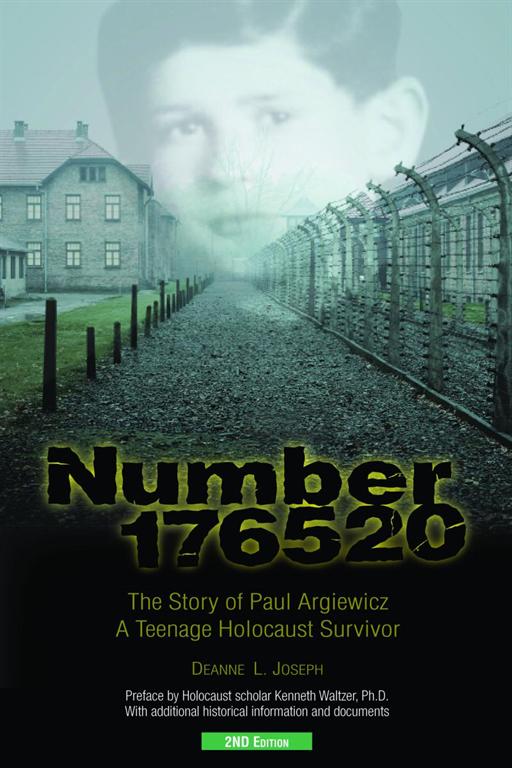
Look how dishonest the book cover is. Paul was not a young child in the camps but 16 to 19 years old. He wasn’t even in Auschwitz except for 2 days, then, according to him, sent to Blechhammer, and spent the last 4 months at Buchenwald.
The preface to the book is written by our old friend, Professor Kenneth Waltzer, and in it he gives “historical documentation.” I would really like to see that. I should order the book and write more about this later; the only thing that stops me is that you and I both know there is no end to this stuff. One thing leads to another. So we’ll see, but for now, enjoy this excerpt. You will notice that not a single person has a name except Paul.
* * *
Deanne L. Joseph’s moving new memoir, Number 176520 –The Story of Paul Argiewicz, a Teenage Holocaust Survivor, poignantly recounts one child’s journey through the terrors. With a preface and historical documentation provided by renowned Holocaust scholar, Professor Kenneth Waltzer (Director of Jewish Studies, Michigan State University), Number 176520 is quickly becoming an invaluable resource for students of the Holocaust.
Following is an excerpt from the book:
Paul and his family lived in the ghetto for about a year. In spite of the dire circumstances, his boyish, adventurous nature remained. He removed the identification patch from his clothing and sneaked out of the ghetto [Sosnowiec, not Warsaw -cy] through an opening in the barbed wire fence. It was an act of defiance that would have landed him at the end of an executioner’s gun had he been caught, but somehow he was able to pull off this rite two to three times a week. [I don’t think an 11-year old boy would be allowed out alone at night by his loving parents, do you? Neither would he have been shot dead if caught.-cy]
Being the gregarious child that he was, he made friends with some gentile children on the “outside.” They did not seem to mind that he was Jewish, and some of their parents even tried to help him in small ways. The father of one of his new friends owned a bakery. The man’s sympathetic conscience obliged him to turn a blind eye, allowing Paul to steal freshly baked bread from his store twice a week. The ritual continued for a year. Sometimes the determined young scavenger managed to find potato peels or other small provisions of vegetables and was always faithful to rush his smuggled goods back to his hungry family behind the fence.
Eventually, Paul became so comfortable in his excursions that he inadvertently lowered his guard and came face to face with disaster. Returning to his family with a pair of stolen loaves of bread, he was approached by two SS officers.
“Where did you get that bread?” they demanded. Paul had never been so close to the enemy. He stood, accused and frozen.
“Come with us!” The order was stern and curt. They snatched the bread from his hands. The pounding of his heart intensified until he thought it would surely break through his chest. He could barely breathe. He felt a hard, squeezing pressure on his arm — the grip of a Nazi. He had the sensation of walking very quickly, although he was unable to feel his legs. Were his feet touching the ground? Were they even moving? He heard only the sound of the officers’ boots clacking with each step on the hard street beneath their feet. His eyes burned as if on fire, and blurred images of his family flashed through his rattled brain. What would they think? Would he ever see them again? Were these men going to kill him? Paul fought to restrain the tears pooling in his eyes. He was only a child — his life was supposed to be ahead of him, not behind.
They arrived at their destination: an old schoolhouse that had been converted into a transitory evaluation and detainment center, the Durkankslager. He was taken downstairs to the basement, the “dungeon.” It was filled with people standing in lines. Everywhere were the familiar Jewish identification patches. The Nazis pushed him into place with the others. He looked around at the detainees, predominantly grown men. He did not see any other children in the crowded space.
An SS officer sat upright on a stool at the front of the room, one leg raised and bent at the knee with his booted foot confidently perched on a table. Behind him was a desk filled with papers. As each of the accused men made his way to the front of the line, he was questioned by the man on the stool, evaluated, and sent into a group either to the right or to the left. Paul was not sure why the men were being divided, but as he drew closer to the evaluating officer, he was overcome with a sense of doom. His mind fired rapid, disconnected thoughts. I’m only a child . . . perhaps if I tell them I’m only 11 years old . . . maybe they will have pity and let me go back to my parents.
Without warning, a man behind him in the line kicked the back of his leg. He leaned into Paul’s ear and spoke quietly but firmly.
“Don’t tell them your real age. Tell them you’re 18.”
How did he know what I was thinking? Paul wondered.
He arrived at the head of the line. No longer did anyone stand between him and the “judge.”
“Name?” “Paul Argiewicz.”“Age?” “Eighteen.”
The words rolled off his lips in perfect Bavarian German. The officer looked up. His dusky eyes examined the youth before him. His brow furrowed, and he observed the boy for a moment. Paul felt as though he had been suspended in space and time. The moment seemed to last an eternity. Surely, he was exposed . . . guilty . . . he had lied . . . to an SS officer! The penalty for such an offense was execution.
“You speak German?” The officer seemed amused. “Yes,” he responded once more in the language he had learned from his playmates.
“You speak with a Bavarian accent. Why?” “My mother is from Bavaria,” he lied again. For another endless moment, the man’s eyes pierced him. Paul was able to manage a convincing expression. Finally, the harshness of the Nazi’s sharply featured face faded, yielding to a smile and a chuckle.
“Go over there,” he said, nodding his head to his left.
Paul moved in the direction of the nod, but he did not understand the purpose of separating the men. Would he be sent to work or to the grave? None of the men seemed to know the fate that awaited them.
They remained in the detainment center for a few more days. Each day they were given small rations of bread and a cup of water. Paul allowed his mind to escape into a place of refuge and peace. He comforted himself with thoughts of his family, memories of good times they had shared, life in Phella’s beautiful home, and the hope that maybe he would soon be returning there.
In the corner of his eye, Paul perceived movement through a window in the damp stone wall. He turned his head to look through the dusty glass. Just beyond the tall barbed-wire fence, his father stood, his eyes scouring the room through the wire and glass. Noah’s eyes found Paul’s. His hand flew over his head waving to his son, his familiar penetrating eyes filled with longing. He held his hand still for a moment and then let it fall limp to his side. He stood motionless, his gaze fixed on his child. [This is a totally fictional account intended to create poignancy. Paul never saw his father through a window.]
Paul’s heart raced within him. An overwhelming urge demanded that he jump to his feet and run to the window. He dared not. To do so would jeopardize not only his fate but also now his father’s. Separated by brick and mortar, barbed wire and guns, and the merciless cruelty of the human heart, father and son looked upon each other for the last time. In that sacred moment, they knew that the bond they shared was beyond man’s reach; it was a bond protected and preserved in eternity. Still, the 11-year-old was overcome by the realization that he might never again feel the loving touch of his father’s strong hands or hear the sound of his voice.
On the cold, hard floor, Paul covered his face and wept. His father was gone. [End of excerpt]
5 Comments
Category Featured | Tags: Tags: Auschwitz tattoos, famous Buchenwald photo, Holocaust fraud, Ken Waltzer, Murray Matzner, USHMM,
Social Networks: Facebook, Twitter, Google Bookmarks, del.icio.us, StumbleUpon, Digg, Reddit, Posterous.
Monday, April 29th, 2013
By Carolyn Yeager
copyright 2013 Carolyn Yeager
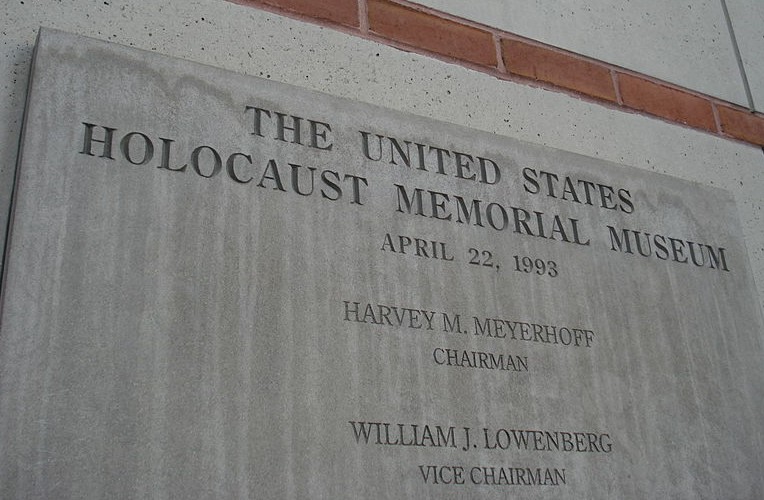 How the United States Holocaust Memorial Museum in Washington DC uses our money to further goals that serve International Jews.
How the United States Holocaust Memorial Museum in Washington DC uses our money to further goals that serve International Jews.
Elie Wiesel and the above-named holohoax museum are as linked together as the military-industrial complex. Wiesel serves Israel and the International Jewish power structure, and in turn, it looks after him and ensures that he is not only wealthy, but famous and covered with honors and decorations that bring him respect.
The United States, since Woodrow Wilson and the 1913 takeover of the U.S. Treasury by the Jewish banking cabal’s Federal Reserve System, has been a captive nation. Even though it appears to be the most powerful nation on earth – that is appearance only if you define a nation as being governed by and serving the people who formed and created that nation.
The truth is, the American people have a foreign parasitical entity attached to our nation, which has changed its very demographic make-up and just keeps spawning more and more anti-American policies. One of the spreading tentacles of this parasite is the United States Holocaust Memorial Museum.
When one studies this museum, how it came into being and how it operates, one can clearly discern it’s parasitical nature – and why, rather than contributing to the national well-being, it takes away from it.
This week, Sunday and Monday April 28-29, is the culmination of several months of “commemoration” of the museum’s 20th year of existence.1 It celebrated its 10th anniversary in 2003, so I assume there will be a propaganda-filled anniversary commemoration every 10 years from now on – and maybe they’ll throw in a 25th too – unless it is put out of business. Following are some reasons the USHMM should be closed down.
It was organized and brought into being under false pretenses and for illegitimate reasons
In the 1970’s , a group of Jews (Elie Wiesel among them) began meeting for the purpose of organizing into a cohesive force to bring about a major memorial to “holocaust survivors” located in the United States.
No Americans had been involved in the deportations or internment in camps in Europe between 1941-April 1945, so a memorial in the U.S. to the people who were had no justification. However, many European Jews had managed to emigrate to the U.S. in the 1950’s and 60’s and formed in enclaves. These Jews were encouraged to use their time-honored tactic of eliciting sympathy for their alleged persecutions in order to win non-Jews over to the cause of Israel.
Since Americans are so highly propagandized (by Jewish Hollywood and Jewish media), it worked. During the 1970’s a highly-watched television miniseries “Holocaust” and lots of magazine and book attention preceded their proposal to President Jimmy Carter to appoint a special commission to look into a U.S. memorial to “The Holocaust.” In 1978 Wiesel sold the idea to Carter, when Carter was having difficulty showing successes by his administration. Winning the favor of the Jewish voting block was an obvious necessity for a second term. In this atmosphere, Carter appointed Wiesel to head The President’s Commission on the Holocaust to explore the idea of a memorial, with the aim, as Wiesel wrote to Carter, of “fighting genocide.” The American people had nothing to say about it.
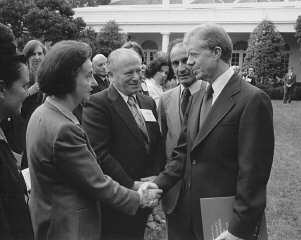 A report was submitted to Carter on Sept. 27, 1979, recommending the establishment of a museum, an educational foundation and a Committee on Conscience. (Did the American people need the Jewish immigrants they had treated so graciously to “prick their conscience” to help them become aware of guilt they didn’t know they had?)
A report was submitted to Carter on Sept. 27, 1979, recommending the establishment of a museum, an educational foundation and a Committee on Conscience. (Did the American people need the Jewish immigrants they had treated so graciously to “prick their conscience” to help them become aware of guilt they didn’t know they had?)
Right: Jewish contributors, The Meeds, meet Pres. Carter as he officially receives the holocaust commission report from Elie Wiesel, standing behind Carter. It’s all politics.
One paragraph taken from the very long report reads:
Granted that we must remember, Mr. President, the next question your Commission had to examine was whom are we to remember? It is vital that the American people come to understand the distinctive reality of the Holocaust: millions of innocent civilians were tragically killed by the Nazis. They must be remembered. However, there exists a moral imperative for special emphasis on the six million Jews. While not all victims were Jews, all Jews were victims, destined for annihilation solely because they were born Jewish. They were doomed not because of something they had done or proclaimed or acquired but because of who they were: sons and daughters of the Jewish people. As such they were sentenced to death collectively and individually as part of an official and “legal” plan unprecedented in the annals of history. [my underlining -cy]
And you might be surprised at the names of the 34 members – some quite recognizable, but all Jews, except maybe Telford Taylor of Nuremberg fame … or is he too?2
Consider that Carter was now gearing up for his re-election campaign, which was going to be very tough, and the members of the House of Representatives were also facing re-election, plus a third the Senate. Congress voted unanimously to establish the U.S. Holocaust Memorial Council, with Elie Wiesel as Chairman.
Once they got that far there was no turning back.
From 1980 to 1993,3 Jews put their plans in motion
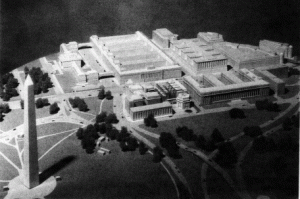 Almost 2 acres of land adjacent to the National Mall were freely given by the federal government (again, without the people’s consent) for the construction of the building, which was paid for by private donations. This way, Jews had total control over the design.
Almost 2 acres of land adjacent to the National Mall were freely given by the federal government (again, without the people’s consent) for the construction of the building, which was paid for by private donations. This way, Jews had total control over the design.
You can see from the model at left (which apparently the museum directors do not want to be seen as it’s not on the USHMM website) how close the museum (which you can recognize by the temple-shaped structure on the Plaza side) is to the Washington Monument, arguably the most defining national monument in the city.
Groundbreaking ceremonies took place in 1985 – you can be sure officiated by plenty of rabbis blessing the effort. They even got one of the streets that bordered the construction renamed Raoul Wallenberg Place.4
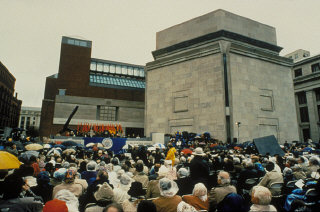 Dedication ceremonies took place on April 22, 1993 (pictured right), and included speeches by President Bill Clinton, Chaim Herzog, president of Israel; Harvey Meyerhoff, Chairman of the Memorial Council; and the museum mascot Elie Wiesel. The sell-out of a nation!
Dedication ceremonies took place on April 22, 1993 (pictured right), and included speeches by President Bill Clinton, Chaim Herzog, president of Israel; Harvey Meyerhoff, Chairman of the Memorial Council; and the museum mascot Elie Wiesel. The sell-out of a nation!
In the following year, 1994, seeking to make more of a connection to American citizens (perhaps there was some criticism as to why this grotesque edifice even existed amongst our national monuments in the prime “tourist” section of our nation’s capitol?), the plaza shown here was dedicated to General Dwight David Eisenhower and the “soldiers who fought under his command.” Guess they had forgotten to do that earlier, caught up as they were in their self-love and self-congratulation.
Twenty years later, the “after the fact” narrative and the guilt-tripping just gets bigger
To mark it’s 20th anniversary, the museum is having a “historic gathering” of ” survivors” and WWII vets, plus a four-city traveling exhibition tour with the aim of impressing into impressionable minds the “continuing relevance of the Holocaust.” The four cities are Boca Raton, Los Angeles, New York and Chicago. It costs a lot of money to send full-scale museum exhibitions around the country like this.
 Today, Monday, April 29, is the big “geriatric parade” at the museum, with speeches by former president Bill Clinton and Elie Wiesel, who were both on hand 20 years ago. They make the claim it was WWII veterans who “ended the Holocaust.” The purpose for that claim is to connect the holohoax to America via the American GI’s who allegedly liberated some of the camps. That’s why Susan Eisenhower (pictured right), granddaughter of ‘General Dwight David,’ was awarded this year’s “Elie Wiesel Prize”, their highest honor. (By engineering a Nobel Peace Prize for Wiesel in 1986, “holocaust survivors” assured themselves of a greater perception of legitimacy.)
Today, Monday, April 29, is the big “geriatric parade” at the museum, with speeches by former president Bill Clinton and Elie Wiesel, who were both on hand 20 years ago. They make the claim it was WWII veterans who “ended the Holocaust.” The purpose for that claim is to connect the holohoax to America via the American GI’s who allegedly liberated some of the camps. That’s why Susan Eisenhower (pictured right), granddaughter of ‘General Dwight David,’ was awarded this year’s “Elie Wiesel Prize”, their highest honor. (By engineering a Nobel Peace Prize for Wiesel in 1986, “holocaust survivors” assured themselves of a greater perception of legitimacy.)
Museum Director Sara Bloomfield emphasized that the museum’s main goal is to honor the memory of the 6 million murdered Jews. “We felt it important (while the vets are still with us) to make a commitment to them that this institution will carry forward this legacy.” Thus, the theme for this 20th anniversary is “Never Again: What you do matters.” It’s actually a giant guilt trip on White Euro-Americans.
The special anniversary exhibition is titled “Some Were Neighbors: Collaboration and Complicity in the Holocaust” (poster for the exhibit pictured right), an allusion to all those guilty ones who stood by and did nothing to prevent the “terrible treatment” of the Jews. What they never consider however, is how many thought the Jews deserved it. Of course, it must be understood that the narrative of the horrendous suffering of Jews has been wildly exaggerated beyond all semblance to the reality. This, however, is not allowed to be said.
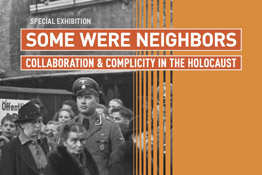 A feature of the exhibit is sound recordings of “survivors” telling their strange stories – like Stanislaw Ochmann who, in Poland, says he transported Jews in a wooden wagon to a cemetery to be shot. As the mothers were raked by machine-gun fire, their little children clinging to their skirts were not hit, but all fell together into the pit and were covered over with dirt. Then – “the earth was moving” because “they were still alive!” This is the typical make-believe these “historians” and “researchers” at the USHMM want Americans to believe.
A feature of the exhibit is sound recordings of “survivors” telling their strange stories – like Stanislaw Ochmann who, in Poland, says he transported Jews in a wooden wagon to a cemetery to be shot. As the mothers were raked by machine-gun fire, their little children clinging to their skirts were not hit, but all fell together into the pit and were covered over with dirt. Then – “the earth was moving” because “they were still alive!” This is the typical make-believe these “historians” and “researchers” at the USHMM want Americans to believe.
The museum spends an inordinate amount of time and resources talking about Nazi Germany. Yet the curator of “Some Were Neighbors,” Susan Bachrach, says she is challenging the idea that the “Holocaust” was primarily about Hitler and other Nazi leaders. “The Holocaust wouldn’t have been possible without enormous indifference (Wiesel’s favorite word) throughout Germany and occupied Europe, but also thousands of people who were ‘just doing their jobs’.”
All of the above indicates that the goal of the powerful Jewish holocaust lobby is to convince Euro-American Whites that it is their duty to forever protect the rights, interests and privileges of Jews in non-Jewish societies. They want to convince us that Jews are the people most vulnerable to persecution, through no fault of their own.
This is the game plan. How is it working?
What does it cost the nation and why not let them do it all themselves?
According to their own accounting, which you can see here, their 2011 financial report5 shows this:
Budget
2011 – $48,400,000 Federal …. $36,500,000 Non-appropriated Total $84,900,000
2010 – $48,000,000 Federal … $33,600,000 “ “ Total $81,500,000
Sept 30, 2011 Financial Position
Cash balance: 16,000,000
Long term investments: 205,179,192
The museum is exempt from income taxes, and presumably property taxes on their prime real estate.
The museum received $48.4 million from the federal government, but they raised $36.5 million on their own. It also has “long term investments” – money invested in stocks and securities – totaling over $200 million. With that kind of money available to them from private sources, they can support this entire project on their own. Without the federal funding, they would get even more money from private donors. The reason they went after federal government sponsorship is to give themselves the legitimacy it brings to their cause: eternal “Holocaust Remembrance.” To be able to present themselves as “speaking for the American nation,” not as speaking for Jewry, which is what they are actually doing.
In the now-official mission statement of the U.S. Holocaust Council, it’s first and only requirement, along with creating a museum memorial, is to conduct the annual civic observance of the “Days of Remembrance.” But they want to go way beyond that. They keep increasing their goals to be achieved. For instance:
In 2011, they continued to expand the victim’s names list and shared the information with Yad Vashem. Assisting a government institution of another nation, using our nation’s funds! In the world’s only Jewish state too. This is clearly Jews helping Jews in a Jewish project that only Jews care about. But also, who cares what the victim’s names are? Add the fact that this is totally unreliable information, but neither the USHMM or Yad Vashem care one bit about reliability, but only whether it’s good-sounding propaganda for their cause.
Another costly project of 2011 was the distribution of 6,500 Days of Remembrance DVD Planning Guides – an increase of 30% over 2010. The Guide was sent to 67 military installations abroad, including Iraq, Afghanistan, Germany and South Korea. These are elaborate how-to packets, featuring historical background material (lies), poster sets, videos, readings, personal histories and even that victim name list. This is pure Jewish propaganda from their point of view only, all coming under the auspices of a U.S. government-approved program.
The museum also “served” over 3000 members of the judiciary in nine states, giving them Continuing Legal Education credits in Ethics (?! Jews are the least ethical people) for completing their course of study. Can it get any more obvious what is going on? The USHMM is in the same business as the Anti-Defamation League of B’nai B’rith. The report also brags that over 2000 law enforcement officials completed “training,” including 150 Chiefs and top leaders.
Finally, they implemented a Propaganda Initiative aimed at journalists and diplomatic officials via special programs such as:
A final note: For their 20th anniversary, the museum launched a campaign to raise $540 million by 20186. It has already secured gifts totaling $258.7 million. The campaign will double the size of the museum’s endowment. Also, a $15 million gift from “holocaust survivors” David and Fela Shapell will help build a new Collections and Conservation Center. This shows the limitless amount of money available to them.
Should the American taxpayers, who are overwhelmingly NOT Jewish and never involved in the holohoax in any way, be used to promote a singularly Jewish perspective on world history and current affairs? The answer has to be no, but then there is that fear of the jews ….
End notes:
1. Some interesting numerology on the date carved into the museum plaque (first picture). Note that the date on the museum is April 22, 1993. That adds up to 4 (april) plus 4 (22=2+2= 4) plus 4 (1993 = 1+9+9+3 = 22 = 4). So it is 4+4+4 = 12. The Twelve Tribes of Israel? Do you think Jews would let their museum founding fall on just any old date?
2. Telford’s second wife, Toby Golick, is Jewish. They had two sons, Benjamin and Samuel.
3. 1980 to 1993 is 13 years. Again, 1+3 = 4. Coincidence, I guess.
4. Wallenburg, a Swedish diplomat, is one of the the “Christian” heroes who “rescued” many Hungarian Jews, according to their narrative.
5. http://www.ushmm.org/notices/performance/2011/performance.pdf
6. The 25th anniversary falls on 2018, so we can believe they will have a big celebration then, too. Don’t we know Jewry will always be working from at least a 100-year plan.
5 Comments
Category Featured | Tags: Tags: Elie Wiesel, Jimmy Carter, President's Commission on the Holocaust, Sara Bloomfield, Stanislaw Ochmann, Susan Bachrach, Susan Eisenhower, U.S. Holocaust Memorial Council, USHMM,
Social Networks: Facebook, Twitter, Google Bookmarks, del.icio.us, StumbleUpon, Digg, Reddit, Posterous.
Monday, April 1st, 2013
By Carolyn Yeager
copyright 2013 Carolyn Yeager
Updated April 7th
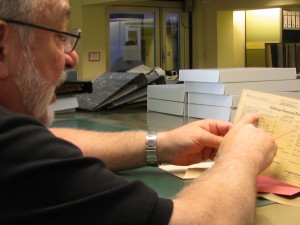
Prof. Kenneth Waltzer is looking at a Buchenwald registration card at the International Tracing Service in Bad Arolsen, Germany.
Kenneth Waltzer is a professor of history at Michigan State University since the early 1970’s. He helped to create the Jewish Studies program which opened in 1992, and which he heads. Waltzer has been researching into evidence of a special ‘boy’s protection program’ run by prisoners at Buchenwald for going on 10 years now. As an “approved” researcher, he is allowed to peruse all the files at the International Tracing Service in Bad Arolsen, Germany, something that is made much more difficult, if not impossible, for revisionists.
Waltzer is considered one of the top scholars in the U.S. of the ill-named holocaust but his work has been sloppy, and his attempts to cover up the sloppiness amount to fraud. This, along with his continual promotion and defense of Elie Wiesel as a Buchenwald survivor, is what has drawn me to study him ever more closely.
Because of the seriousness of the charge I am making against him, I will list right up front my reasons for thinking it is time for such a call. They are:
- Waltzer habitually tells fibs in the form of false information which is intended to mislead. When called out for it, he tells more fibs to cover for the first ones.
- He has been in the service of the “Holocaust Industry,” not academic rigor and fair-mindedness, from the very start of his career.
- He knowingly defrauds his students, his university and the public (you and I) with his dishonest “holocaust scholarship.”
- While he is drawing high pay as a tenured American professor of history at MSU, he is working to advance the State of Israel.
I am going to show that these charges have a strong basis in fact. Fraud is commonly understood as dishonesty calculated for advantage. A person who is dishonest may be called a fraud. In the U.S. legal system, fraud is a specific offense with certain features. (see here)
Legally, fraud must be proved by showing that the defendant’s actions involved five separate elements: (1) a false statement of a material fact, (2) knowledge on the part of the defendant that the statement is untrue, (3) intent on the part of the defendant to deceive the alleged victim, (4) justifiable reliance by the alleged victim on the statement, and (5) injury to the alleged victim as a result.
I am not intending to bring legal charges of fraud against Prof. Waltzer, but to try him in the court of public opinion. Therefore, it will be up to Waltzer to defend himself against my charges.
* * *
Two years ago, I asked the question on this web site: “What happened to Ken Waltzer’s book about the boys of Buchenwald?” It was claimed to be, at that time, in it’s final stages. Eight years after he publicly announced he was researching for a book about the so-called children’s barracks at Buchenwald (Barracks #66 ), it still has not materialized. Five years after his book was described as “upcoming,” it still has not materialized. During this time, he has not produced another book, or any major work that would have taken precedence over this book. So what is the delay?
It’s pretty plain that the book’s thesis has shifted considerably since 2005, when his MSU website featured Elie Wiesel as the most recognizable and famous child survivor from Buchenwald. That website was taken down between one and two years ago and is completely wiped clean from the Internet. The banner on all the six to eight pages that were included showed a photograph very similar to the one below of the “boys” being marched out of the main Buchenwald camp to temporary quarters at the former SS barracks.
The USHMM (national holocaust museum in D.C) website dates this picture as being taken on April 17, 1945, six days after liberation.1 At this time, Elie Wiesel, by his own account in two books, was laying in a hospital sick almost unto death from food poisoning. Details like this don’t deter Prof. Waltzer from backing up in every instance the standard holocaust narrative. “Elie Wiesel in Buchenwald” is the standard narrative, so evidence must be found for it.
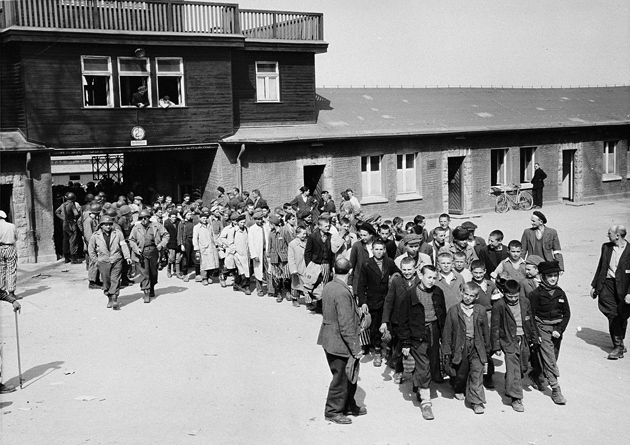 Ken Waltzer claimed for years that one of these boys was Elie Wiesel. But Wiesel is not in this picture!
Ken Waltzer claimed for years that one of these boys was Elie Wiesel. But Wiesel is not in this picture!
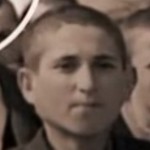 From at least 2005 (eight years now), Waltzer has identified the boy third or fourth from the front (hard to tell) in the left-side column (dressed in a black suit and in front of the tall boy wearing a beret) as Elie Wiesel, based on nothing but his own fraudulent intention that there was enough resemblance that people would believe it if he said so. In this article , I exposed this lie. Waltzer has never admitted that he was mistaken or was perpetrating a falsehood that he intended to put into his book. Instead, what he did when his fabrication was sufficiently exposed was to take the entire site down and not mention it again.
From at least 2005 (eight years now), Waltzer has identified the boy third or fourth from the front (hard to tell) in the left-side column (dressed in a black suit and in front of the tall boy wearing a beret) as Elie Wiesel, based on nothing but his own fraudulent intention that there was enough resemblance that people would believe it if he said so. In this article , I exposed this lie. Waltzer has never admitted that he was mistaken or was perpetrating a falsehood that he intended to put into his book. Instead, what he did when his fabrication was sufficiently exposed was to take the entire site down and not mention it again.
Left is a close-up of the boy Waltzer has maintained for several years is Elie Wiesel. Anyone can tell it is not and that’s why no one else ever publicly agreed with him.
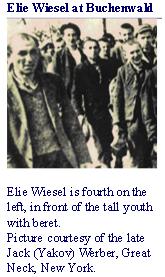 I have some of what was on that site copied into articles here at EWCTW and also in my files. At left is the cropped section of the photo that Waltzer used on the banner of his MSU-Newsroom/Holocaust website that was very much dedicated to Elie Wiesel. (Another reader, Chris, informed me that he had found pages from the site using the Way Back Machine. Many thanks to him.) This shows that Waltzer definitely identified the boy in the black suit as Elie Wiesel. In addition, Jack Werber, a known dishonest survivor, was the supposed supplier of the picture.
I have some of what was on that site copied into articles here at EWCTW and also in my files. At left is the cropped section of the photo that Waltzer used on the banner of his MSU-Newsroom/Holocaust website that was very much dedicated to Elie Wiesel. (Another reader, Chris, informed me that he had found pages from the site using the Way Back Machine. Many thanks to him.) This shows that Waltzer definitely identified the boy in the black suit as Elie Wiesel. In addition, Jack Werber, a known dishonest survivor, was the supposed supplier of the picture.
Below right, a screen shot of one of the pages as it existed then, sent by a friend of EWCTW. It shows more of the emphasis on Elie Wiesel.
When I pointed out much of this in a podcast of March 25th, Waltzer sent me an email on March 28th stating,
My websites at UM FLint are down because I was appointed there one year and am now back at Michigan State.
Of course I never mentioned UM Flint and never even saw his website there. I was speaking about his MSU website, which was titled something like Ken Waltzer’s “MSU Newsroom Special Report.” It was full of information about his projects and especially what he calls “the rescue operation of children at Buchenwald.” It was up on the Net since at least 2008 2, then suddenly disappeared, with not even cache pages to be found. Did Waltzer tell me a fib, or did he just read the podcast program description and misinterpret what it said about “taking down web pages?” By now, he will know what I mean and may answer.
 I think it is very possible that he timed the take-down of his MSU “Newsroom” site with his one-year visiting professorship at UM Flint — putting up a temporary website there which he could take down when he left. This is a way of confusing the picture in order to distract as much as possible from his more recent decision to put more distance between himself and his prior (false) assertions about Elie Wiesel.
I think it is very possible that he timed the take-down of his MSU “Newsroom” site with his one-year visiting professorship at UM Flint — putting up a temporary website there which he could take down when he left. This is a way of confusing the picture in order to distract as much as possible from his more recent decision to put more distance between himself and his prior (false) assertions about Elie Wiesel.
His intention was and is clearly to deceive. The harm is caused to ordinary people who believe and trust that they are getting knowledgeable answers from a professor of history and a holocaust scholar. In this particular case, all five of the elements necessary to prove fraud are there.
First, he sets up a University-sponsored website maintaining falsely that Elie Wiesel is the boy in the photograph of youthful “survivors” marching out of the camp (1). He knows it is false because he has no evidence or proof, only his own “wishful thinking.” The USHMM never identified Wiesel in that group of boys, nor did anyone else (including Wiesel himself), unless they did so from following Waltzer’s example (2). Waltzer’s intent was to make the public believe something that was not true – that he had proof of Elie Wiesel being one of the “rescued children” (3). Because Waltzer is a Professor of History and “holocaust expert” at a major university, and is at all times written up very favorably in the media, the public (you and I ) and his students will rely on his statements (4). These same students and public are injured when photographs are mislabled in order to foist on them a certain belief about an influential historical event that affects their entire world view (5).
* * *
This is just one instance of the untruths that Ken Waltzer has told over the years. Another tactic he uses is to promise an upcoming answer to your doubts which he cannot or does not produce now. As we have seen, we continue to wait as he continues to promise. Still another tactic is to accuse others of lying when it is he who is doing so. But only people who are knowledgeable enough about these complex and purposely obscured issues can see who is doing the lying. In this same email, he wrote:
The book is on track, and I have also completed a separate essay to be published on Elie Wiesel and Buchenwald.
Completed, he says. And separate. Why separate? I wrote back to him asking where I could find his essay because I wanted to read it. No reply – which is typical because factual information is not his forte, emotional rhetoric is. I feel it’s quite possible he wrote a separate essay on Elie Wiesel so as not to tarnish his book with the false “facts” about Wiesel in Buchenwald. He can always get rid of an essay, if necessary, later – but not his entire book. What might there be in this essay? Will it be the same or quite different from what he wrote in a March 6, 2010 comment at Scrapbookpages Blog, when he said [my underlining-cy]:
For the skeptics [I was using the name skeptic then -cy] and know-nothings who have written in suggesting Eli Wiesel was not in the camps, that Night is purely fiction, you are all dead wrong. The Red Cross International Tracing Service Archives documents for Lazar Wiesel and his father prove beyond any doubt that Lazar and his father arrived from Buna to Buchenwald January 26, 1945, that his father soon died a few days later, and that Lazar Wiesel was then moved to block 66, the children’s block in the little camp in Buchenwald. THese documents are backed up by military interviews with others from Sighet who were also in block 66, and by the list of Buchenwald boys sent thereafter to France. All of this is public domain.
Wishful thinking by Holocaust deniers will not make their fantasies true. While Wiesel took liberties in writing Night as a literary masterpiece, Night is rooted in the foundation of Wiesel’s experience in the camps. The Buchenwald experience, particularly, runs closely to what is related in Night.
Comment by kenwaltzer — November 14, 2010 @ 6:57 am
How much untruth is contained in this, in order to defraud us all in his devoted service to the “Holocaust Industry” and the state of Israel? Plenty. As proof that Elie Wiesel was in Buchenwald, he points to documents for Lazar Wiesel and “his father.” It is even more absurd because Lazar Wiesel’s relative was only 13 years older than Lazar – it was in fact his brother Abram! Waltzer is passing off Lazar for Elie simply on the basis that Lazar also came from Sighet, Elie’s hometown and carries the same name. Sighet was a city of 50,000 or so with a very large Jewish population, and Wiesel was a common name. But the “scholar” who has taken years to research this and still isn’t finished, wants us to believe there can be only one Lazar Wiesel, who is Elie. He attributes the difference in their birthdates to bureaucratic error.
Previously I may have called this stupidity, but now I’m calling it fraud, based on the above-given definition. Of course Waltzer can see the discrepancies here, but he hopes he can convince you not to see them. The Military Interview mentioned with Lázár Wiesel’s name on it also does not have the right birthdate for Elie Wiesel, nor does the signature match Elie’s well-known signature.
Will Waltzer repeat this nonsense in his latest “completed” essay? Notice that Waltzer never fails in the name-calling department, here calling his critics names such as “know-nothings” and “Holocaust deniers.” Several months later, he wrote a similar comment at EWCTW to the blockbuster article: “Signatures Prove Lázár Wiesel is not Elie Wiesel”
by kenwaltzer
On November 14, 2010 at 10:34 am
Contrary to Carolyn Yeager’s wishful thinking, Eli Wiesel was indeed the Lazar Wiesel who was admitted to Buchenwald on January 26, 1945, who was subsequently shifted to block 66, and who was interviewed by military authorities before being permitted to leave Buchenwald to go with other Buchenwald orphans to France. Furthermore, there is not a shadow of a doubt about this, although the Buchenwald records do erroneously contain — on some pieces — the birth date of 1913 rather than 1928. A forthcoming paper resolves the “riddle of Lazar” and indicates that Miklos Gruner’s Stolen Identity is a set of false charges and attack on Wiesel without any foundation.
The promise of a forthcoming paper turned out to be a fib. From Nov. 2010 to now, there has not been any paper. Maybe it’s the essay he mentioned in his March 28th email? “Forthcoming” to Waltzer means up to two and a half years, it seems. That in itself is the sign of an unreliable person.
There can be only one reason Ken Waltzer allows himself to look like a buffoon and a shyster. He doesn’t need to do it to keep his position at Michigan State University. He does it because it is his larger job to keep the Buchenwald atrocity stories and Liberation lies, including the Elie Wiesel myth, alive and well in the mind of the public. He works for purely Jewish interests – I will be writing a future article on the priority, meaning and funding of Jewish Studies programs in American universities. For now, I can add that Waltzer is more of a public relations (PR) worker for the Holocaust Industry, the State of Israel and maybe AIPAC, than he is an honest-to-god academic. Another organization connected to Israel that he serves is Scholars for Peace in the Middle East. He has written four attack-dog articles for them since 2009, functioning in a sort of Abe Foxman-pitbull style.
In Nov. 2009, he attacked Alison Wier as another “know-nothing” because she speaks up for Palestinian rights on college campuses, where she is popular.
In May 2010, he went after John Mearsheimer for calling Israel “an apartheid state” and also took out after Noam Chomsky, Norman Finkelstein, and “the crackpot Phil Weiss.”
Also in May 2010, another target was Judith Butler, who campaigned at the Berkeley campus for the university “to divest from companies making military weapons which Israel employs to commit war crimes.”
In August 2011, he wrote on the Israeli-Palestinian peace process, arguing for Israel’s interests to be well and strongly presented on college campuses.
But this is only the tip of the iceberg when it comes to Walzer’s pro-Israel activities. I will be writing further articles that present the evidence for Ken Waltzer being guilty of fraud in his public writings and during his entire career. Much of it revolves around Elie Wiesel and the Industry’s need to place him at Buchenwald. My position, if you have somehow missed it, is that Elie Wiesel was never at Buchenwald. I am also saying that Waltzer is backing down or “stepping back” from his blatant, dishonest claims about Wiesel, but he can’t back down altogether.
Endnotes:
1. I have also seen it dated April 27 at the USHMM and have used that date in other articles here. Now I have only found this one picture which is very officially dated the 17th. There may have been an attempt to move the date to the 27th so that Wiesel could be in the picture (though he supposedly would not have been released from the hospital until the 28th). It is really too bad the USHMM cannot be relied upon; nor can Yad Vashem. When the museum “researchers” are involved in lying or in complacency, one really has nowhere to turn.
2. http://msutoday.msu.edu/news/2008/mapping-the-holocaust-archive-msu-prof-explores-records-of-nazi-atrocities At bottom of article, it reads “For more information, and to follow Waltzer’s research and read his journal as he participates in the workshop, visit the special report at: http://special.newsroom.msu.edu/holocaust.” This is a link to the website that no longer exists, as you will see if you click it. Now he seems to be pretending it was never there.
11 Comments
Category Featured | Tags: Tags: Abram Vizel, Buchenwald camp, Buchenwald liberation, Elie Wiesel, Holocaust Industry, Israel, Ken Waltzer, Lazar Wiesel, legal definition of fraud, M. Grüner, Michigan State University, Night, Scholars for Peace in the MIddle East, USHMM,
Social Networks: Facebook, Twitter, Google Bookmarks, del.icio.us, StumbleUpon, Digg, Reddit, Posterous.
Friday, December 28th, 2012
By Carolyn Yeager
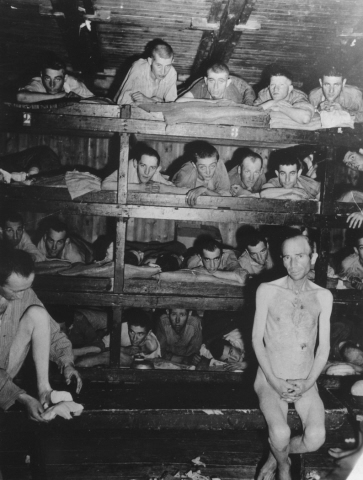 Here we see a very bizarre scene of clothed men being photographed lying in bunks, while a naked man sits on a bench in front of them. They are not looking at him and he seems unaware of them. And why not? This is clearly a composite photograph made up of two unrelated scenes.
Here we see a very bizarre scene of clothed men being photographed lying in bunks, while a naked man sits on a bench in front of them. They are not looking at him and he seems unaware of them. And why not? This is clearly a composite photograph made up of two unrelated scenes.
The United States Holocaust Memorial Museum (USHMM) titles this photo #78713 “Survivors lie on wooden bunks that are four tiers high in a barracks in the Buchenwald concentration camp.”
No mention of the naked man. This is truly fitting of the expression “the elephant in the living room” wherein everyone pretends not to notice something they can’t or don’t want to try to explain.
The description by the USHMM goes on to say:
The original caption reads, “This photo shows the conditions and the amount of sleeping space for the prisoners at Buchenwald concentration camp. They range from young kids to old men, all doing the same amount of work each day.”
According to the Signal Corps caption, the photo was taken on April 23, 1945.
Yet the official date given for this photo on the USHMM Online Archive page is: Wednesday, April 11, 1945 – Monday, April 23, 1945; the photographer Donald R. Ornitz; courtesy of Mary Dickinson.
April 11 was “Liberation Day” and they always want to give the impression that all the pictures were taken on that day — that everything seen is unrehearsed and just as the liberating army found it. Yet this photo was “set up” 12 days after liberation. Another point: Where are the “old men,” and where are the “young kids” in this photo? They all look to be in their late teens and 20’s up to their 30’s at the most. No old men, no young kids. What were these ex-‘prisoners’ doing during those 12 days; where were they living? How were they being treated? Well, they were being asked to participate in the creation of the post-war propaganda ordered by Eisenhower, and that is what they did. Were they paid? What were they promised? Did they just hang around in the barracks as usual?
The naked man and his strange shadow
The men in the bunks are not sick or emaciated – they appear healthy and alert – so the military intelligence division responsible for creating photographic propaganda decided to add a sick man to the photo in order to support the message they were charged to send to the world of sub-human conditions at Buchenwald. It’s not hard to see how they did it — the two men on the bench were super-imposed on the other picture. The top edge of the bench is lined up with the bottom slat of the bunk, giving the impression that the bench is some feet away from the bunk. [I’ve copied the photo again for ease of seeing it while reading.]
 So far so good. But once again, the shadows present a problem. Notice that there is a dark shadow behind every man in the bunk cast on the wall behind him, due to the bright flash of the camera and maybe even a spotlight shining on them. The naked man also has a similar black shadow around his head and along his right side although there is only empty space behind him. There is no wall, so what is the shadow being made on? Notice there is no shadow created by his legs. This shadow seems to me to be totally impossible. We don’t see a shadow made “in the air” behind the standing naked man in the Famous Buchenwald Lie-beration photo discussed in the previous posts. But here we do.
So far so good. But once again, the shadows present a problem. Notice that there is a dark shadow behind every man in the bunk cast on the wall behind him, due to the bright flash of the camera and maybe even a spotlight shining on them. The naked man also has a similar black shadow around his head and along his right side although there is only empty space behind him. There is no wall, so what is the shadow being made on? Notice there is no shadow created by his legs. This shadow seems to me to be totally impossible. We don’t see a shadow made “in the air” behind the standing naked man in the Famous Buchenwald Lie-beration photo discussed in the previous posts. But here we do.
One can only explain these two men’s presence in the picture by assuming they were photographed in a hospital or clinic setting where they were being examined or treated; perhaps the man on the right was asked to be photographed nude to make a record of a “mistreated, starved victim of the Nazis,” while he was in reality a victim of disease. His demeanor is one of both defenselessness and humiliation, just perfect as propaganda.
Update! January 7, 2013
Another consideration, brought to mind by Tom’s critical comment, is that the naked man appears to be photographed from slightly above, because we are looking down on his legs and he has no visible neck. But we’re viewing the men in the bunk from a lower position, with the camera flash lighting up the two upper rows. Studying it enlarged 400% on Internet Explorer, there definitely appear to be two camera angles. In addition, the shadow made by his left foot is not convincing; why isn’t it flat on the floor? The black area to the right of his right foot is the leg of the bench.
Might as well repeat here, as I wrote in my reply to Tom in the “Comments”: The shoulders and upper arms of this seated man (and his ear!) are very white, while the rest of his body including his face have a light greyed tone. The difference runs from his neck to his armpit, exactly the same on both sides. It cannot be possible that he wore clothing outdoors that only covered his shoulders and upper arms, leaving the rest exposed! No, the most likely answer is that the arm and shoulder areas have been painted in … for whatever reason. Plus, where is this man’s navel? He doesn’t have one.
The other seated man on the bench looks larger in size, especially noticeable is the head and the hands. I see some signs of retouching on him — the dark line behind his raised knee and the wrinkle lines on the sleeve covering his left arm. Neither look natural.
A mislabeled photo – turning Germans into Jews
The picture of four men, below right, is in the Museum’s Buchenwald photo archives labeled as “Group Portrait of Four Jewish Youth at liberation in Buchenwald,” photo #27289. It’s dated Wednesday, April 11, 1945 (Liberation Day!), courtesy of Morris Rosen; no photographer listed. It adds this information: “Nucher, (the donor’s friend) is pictured in the lower left. Pictured in the center is Jacob Rosenthal from Satu-Mare.”
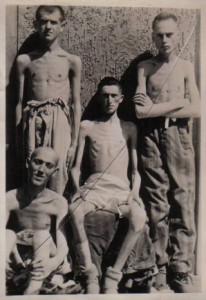 Consider the extent of the irresponsible misinformation on the USHMM website when you learn that these are German men after being interned at the notorious Bad Nenndorf secret prison set up in Germany by the British during their occupation of north-west Germany in 1945. I used this photo in the post for my Oct. 29 radio program The Heretics Hour. The treatment of the prisoners in this camp by the British was far worse than anything experienced by those at Buchenwald. Below are more pictures of documented Bad Nenndorf victims. All suffered from actual, unnecessary starvation.
Consider the extent of the irresponsible misinformation on the USHMM website when you learn that these are German men after being interned at the notorious Bad Nenndorf secret prison set up in Germany by the British during their occupation of north-west Germany in 1945. I used this photo in the post for my Oct. 29 radio program The Heretics Hour. The treatment of the prisoners in this camp by the British was far worse than anything experienced by those at Buchenwald. Below are more pictures of documented Bad Nenndorf victims. All suffered from actual, unnecessary starvation.
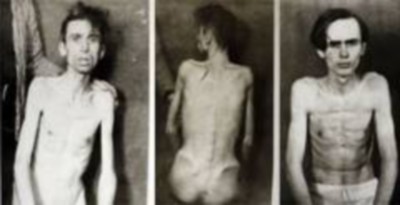
More needs to be done to expose all the photographic “evidence” in the USHMM archives that are forgeries or are mislabeled. There is obviously no vetting or double-checking of what is turned in by Jewish contributors; it’s accepted and catalogued “as is,” just like at Yad Vashem in Israel. We must realize that there is very little about the “Holocaust” that is not fraudulent, either by design or through negligence. The USHMM is a totally Zionist operation and thus is a propaganda mill, not an institution pursuing historic accuracy.
Tutorial on Cast Shadows
In case some readers have trouble understanding shadows and why the shadow “drawn” around the head and body of the seated man (or he was originally seated in front of a wall) are a give-away for forgery, I am presenting two images here that should explain it.
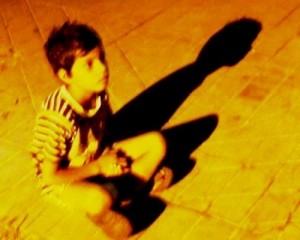 Notice that the shadow cast by this boy (right) sitting in open space is not around his body but on the ground. Shadows cannot be seen “in the air” but only on a surface.
Notice that the shadow cast by this boy (right) sitting in open space is not around his body but on the ground. Shadows cannot be seen “in the air” but only on a surface.
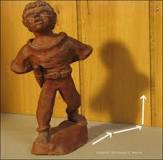
Likewise the statue at left is a short distance away from a wall. But notice that the shadow follows the floor before it reaches the wall, making the shadow on the wall quite a bit shorter than the object itself.
12 Comments
Category Featured | Tags: Tags: Bad Nenndorf, Buchenwald Lie-beration, bunks, composite photograph, forgery, USHMM,
Social Networks: Facebook, Twitter, Google Bookmarks, del.icio.us, StumbleUpon, Digg, Reddit, Posterous.
Wednesday, December 19th, 2012
By Carolyn Yeager
copyright 2012 carolyn yeager
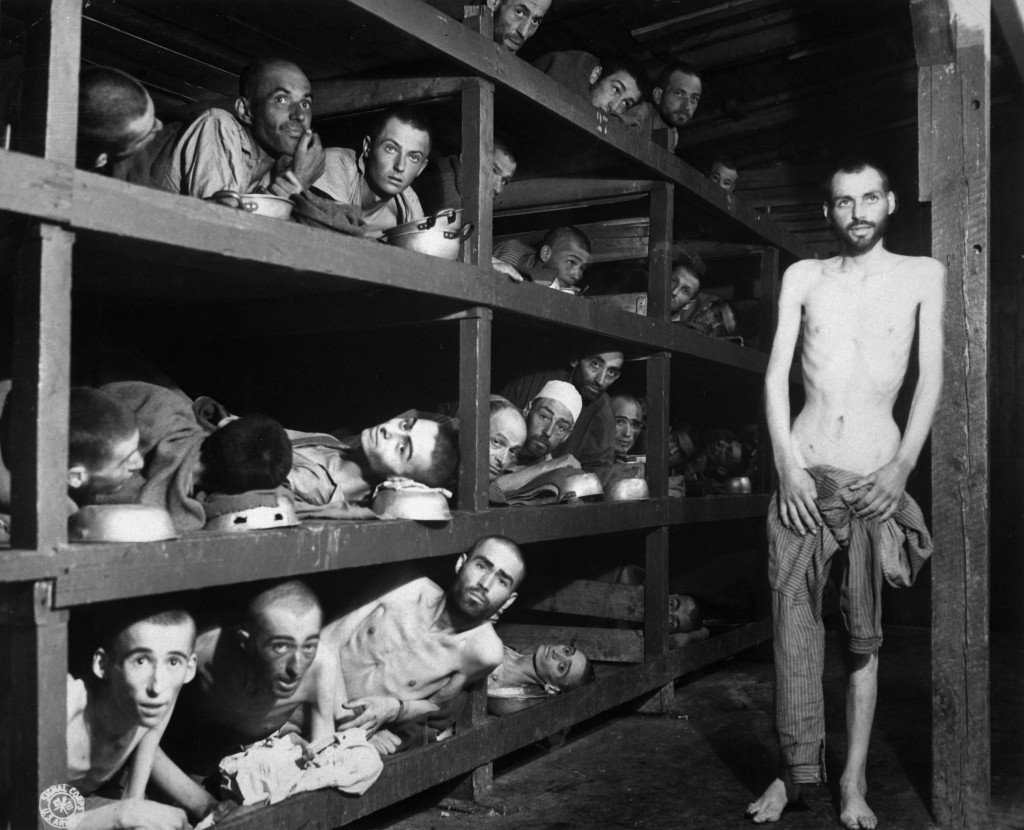
This is the photograph that Allied Supreme Commander General Dwight David Eisenhower ordered, in April 1945, to be posted in every German town and city 1 to show the defeated population the “true meaning of Nazism.”
Was this photo made to order according to Ike’s specifications?
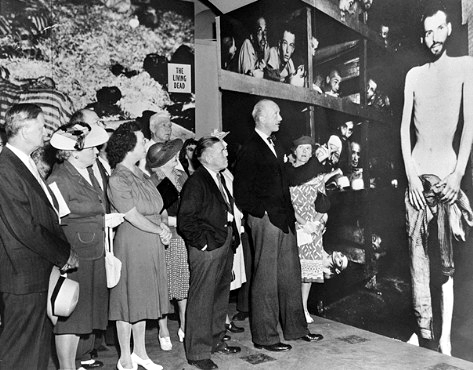 A huge blown-up version then went on tour in the United States for the same purpose, to impress on the American people what evil they had gone to war against; why the sacrifice of blood and treasure was justified! Left: “A traveling exhibit of larger than life size photographs was first shown in St. Louis, MO in summer 1945 and then taken to Washington, DC.
A huge blown-up version then went on tour in the United States for the same purpose, to impress on the American people what evil they had gone to war against; why the sacrifice of blood and treasure was justified! Left: “A traveling exhibit of larger than life size photographs was first shown in St. Louis, MO in summer 1945 and then taken to Washington, DC.
It was plastered on the front pages of newspapers across the country. Thus it became one of the most iconic images representing WWII and of what later came to be known as “The Holocaust.” The intention was to portray the war as a noble effort to “save the Jews from enslavement and extermination,” just as the equally bloody American Civil War had come to be taught as a war “to free the slaves,” i.e. the Negroes who were not citizens of the country they were living in.
Both are black propaganda campaigns that still use whatever is at hand, whether it be subterfuge or not.
In the case of the above photograph, we have learned that the standing figure, the part that makes the biggest, most memorable impact on the viewer, was added later – it was not in the original photo allegedly taken by Private H. Miller of the Civil Affairs Branch of the U.S. Army Signal Corps on April 16, 1945, five days after the “liberation” of the Buchenwald Concentration Camp by American forces.
A blogger, the owner of the Winston Smith Ministry of Truth website who goes by the nickname Black Rabbit, decided a week or so ago, out of curiosity, to order the New York Times newspaper article from May 6, 1945 in which this photo was published, and when it came the photo looked like this:
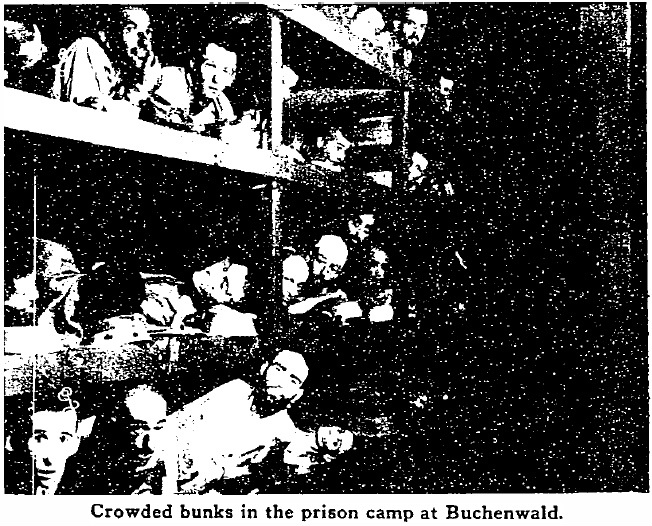
Here is page 2 and 3 of the New York Times article (click to show entire page):
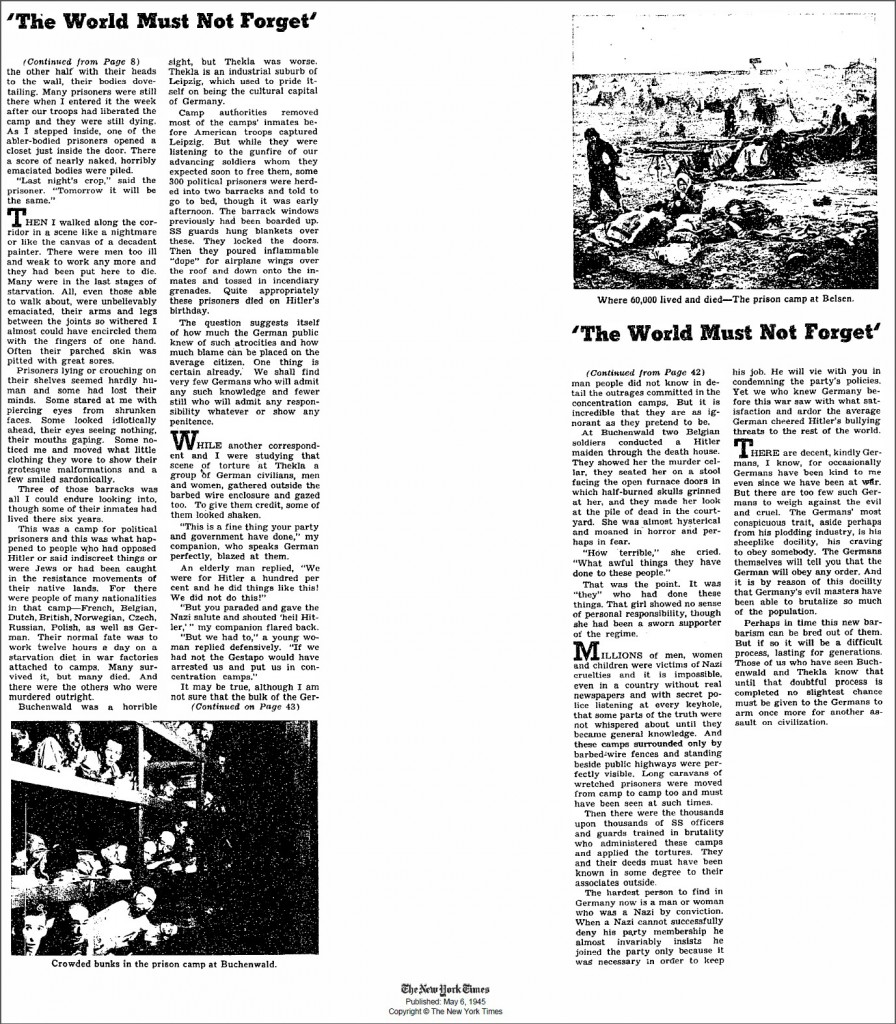
What a shock to see only an empty dark space, and in the New York Times no less!
What happened to the standing man? I was the first to bring it to the attention of the participants in the comment section of furtherglory’s Scrapbookpages Blog after Black Rabbit posted a link to the original article there, and then we quickly began noticing the tell-tale signs of FORGERY about this strange figure who had always appeared odd to me standing there naked as he is, but did not arouse enough suspicion amidst all of the onslaught of “holocaust” imagery, stories and news articles with which we are constantly being bombarded. We see what we are supposed to see, what we’re told we’re seeing, and almost always leave it at that. It is also one of the better photo-forgery jobs of Allied holocaust black propaganda – could that be because it was being done at the behest of the Supreme Commander himself?
But let me point out some problems with this figure:
- His position in relation to the post is an impossible one (see top photo; click once on image and then again for full enlargement). He is not leaning against the post, but neither is he standing in front of the post. His feet are in line with the base of the post, but his left shoulder and arm are in front of the post – without any shadow of any kind. There is something ghostly about this figure, as though he’s an apparition.
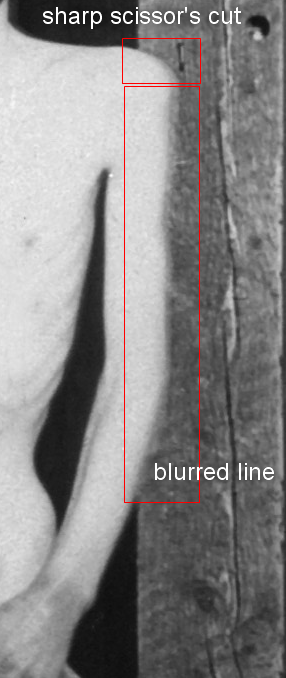 The edge of his left arm is fuzzy, as if it is drawn or painted where it meets the post (detail right). The rest of the outline of his shoulders and arms is very sharp, as though cut with scissors. [In most large-scale reproductions of this photo we have seen (as shown on the Winston Smith Blog), the left edge of the arm is cropped because the larger the image the more noticeable it is.
The edge of his left arm is fuzzy, as if it is drawn or painted where it meets the post (detail right). The rest of the outline of his shoulders and arms is very sharp, as though cut with scissors. [In most large-scale reproductions of this photo we have seen (as shown on the Winston Smith Blog), the left edge of the arm is cropped because the larger the image the more noticeable it is.- Notice the blinding whiteness of his torso, and how different it is from his face, hands and legs which are darker (top photo again). The more one studies the torso and arms, the more they look like a drawing rather than a photograph. Notice how faint are the nipples and definition on his chest compared to the man in the lower bunk who is pushing himself forward the better to be seen.
- Notice the relaxed, almost dreamy expression on the face of the standing man (detail below): his lips are parted in a smile; his eyes are looking off into the distance, not at the photographer. He appears in an untroubled state of mind, unsuited to the environment he’s in and unlike the other men .

- 5. A light source seems to be coming from above right as we face the photo, but the shadows on the legs and feet suggest a light source directly from above. Also, the angle of the shadows on the floor made by the post and by the right leg of the standing figure are not aligned.
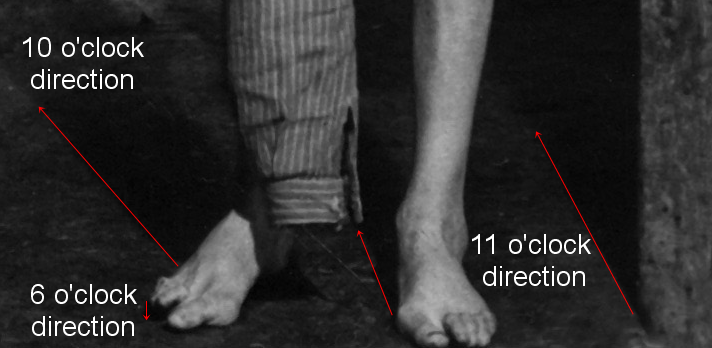
6. Ask yourself why he would be standing there completely nude, with that unlikely expression on his face, five days after the liberation? Also ask yourself why these men would still be lying in these bunks fully dressed, though some having taken their shirts off for effect, five days after the liberation? The only answer is that it’s a staged, arranged photo-shoot for propaganda purposes, not an impromptu entry by a photographer right at the time of liberation – as we are led to believe (because we are supposed to believe it) by the captions that accompany the photo. For example, in the Moberly (Missouri) Monitor-Index on April 30, 1945, the caption to this photo reads: “Slave laborers in their crowded rough bunks in the Buchenwald concentration camp near Jena, Germany, as they were found when U.S. troops of the 80th Division entered the camp.”
Fakery such as this is common in war propaganda; it just usually doesn’t last so long
We not only have the NYT newspaper article showing the photograph without the standing man, but we can also point out tell-tale signs that this figure was added to the photo … and that it was itself doctored to show a very skinny torso of a “starving” man. What deceit! If Eisenhower propaganda specialists had really found such scenes, they would not have had to invent them!
And yes, I’m asking how many personnel were aware, had to be aware, of this type of forgery. And some still living who are still perfectly aware that “The Holocaust” was and is a post-war intelligence operation with no holds barred. For example, so many of the photos that are archived and sold to the gullible public by the propaganda mill that goes by the name of the United States Holocaust Memorial Museum (USHMM) (using your tax dollars) are wildly mislabeled. The USHMM identifies this very photograph as follows:
Former prisoners of the “little camp” in Buchenwald stare out from the wooden bunks in which they slept three to a “bed.” [Photograph #74607]
Elie Wiesel is pictured in the second row of bunks, seventh from the left, next to the vertical beam.
The man in the bottom left hand corner has been identified as Michael Nikolas Gruner, originally from Hungary, Gershon Blonder Kleinman or Yosef Reich. Isaac Reich is in the bottom row, second from the right and Max Hamburger is on the bottom row, fourth from the left. Perry Shulman from Klimitov, Poland is on the top bunk, second from the left (looking up). The man in the second row, third from left has been identified as Dawid Najman. The man in the second row, fourth from the left has been identified as Abraham Hipler; Berek Rosencajg from Lodz or Zoltan Gergely from Cluj. The man on the third bunk from the bottom, third from the left, has been identified as Ignacz (Isaac) Berkovicz, Abraham Baruch and Paul Argiewicz . Juraj (now Naftali) Furst is pictured in the third bunk, fifth from the left. Standing on the right is Chaim David Halberstam.
Others say the standing man is Simon Toncman, who after the ‘Liberation’ returned to his home country The Netherlands, started a family and became a successful businessman. He refused to talk about this photo until the day he died. 2 (Why would that be? Because he knew it was a fake! And because he had been told to keep quiet about it. That’s the best, and only reasonable explanation.)
Of the identified men, one is definitely mis-identified! — and that is Paul Argiewicz. The real Paul Argiewicz was discovered by furtherglory; I picked up his work here (scrowl down to the German drivers license). How could the “Jewish Organizations” with access to Bad Arolson get that so wrong? They all do it all the time. For example, the ‘meantime -Allen Hall” article says that “Red Cross records show Heiman Leefsma survived Barrack 56 as a 20-year-old.” Yet when we see who he is identified as in the Flicker picture, he has a balding head and looks like the oldest man there.
And then there is Elie Wiesel! Please see especially here for proof that the man in the bunk is NOT Elie Wiesel. So that is more fakery surrounding this photo, but in this case the person was really in the original photograph, but is an unknown person. The decision to call that man Elie Wiesel was only made around 1983, with a Nobel Prize in mind.
Both the USHMM and the Allan Hall article are full of errors. There is no need for holocaust “historians,” filmmakers, or “researchers” to be concerned about accuracy — it doesn’t matter how iconic or world-famous they are. Sloppiness goes unpunished, especially since so much of it is on purpose — to deceive and keep the myth going. I will be posting about some other fraudulent pictures from Buchenwald in the future.
End Notes:
1. “US army commander General Dwight Eisenhower ordered this picture to be posted in every German town and city to show the defeated population the true meaning of Nazism,” writes Allan Hall. http://www.meantime.com.au/mean-time-articles/2008/8/12/60-years-on-the-faces-of-nazi-shame-get-their-names-back/
2. Same source (meantime.com): Quote – “Now, 63 years after they were liberated, they have been united again in print by a German newspaper granted rare access to the files of the Red Cross Tracing Service at Bad Arolsen, Germany.
Using the original German SS registration cards and the camp’s “Todesbuch” – book of death – researchers were able to match up names with Jewish organisations around the globe.
Paul Argiewicz, 82, is now living in the US. He lost his parents in the gas chambers and is a regular on American TV shows talking about his experiences.
Red Cross records show Heiman Leefsma survived Barrack 56 as a 20-year-old. A Dutch national, he vanished shortly after liberation and inmate 130305 has not been heard from since.
Nikolas Gruener, now 80, is a Hungarian Jew who was suffering from TB at the time of liberation. “We warmed ourselves on the bodies of the dead before they cooled down,” he said. A successful businessman after the war, he took part in a number of interviews recently for director Steven Spielberg’s Holocaust archive. He lost his parents and two brothers in the camps.
Max Hamburger is now 88. He was active in the resistance in Amsterdam. He survived the death factory of Auschwitz because he was employed as a medic and went on to Buchenwald, where he weighed just 19 kilograms at liberation. After the war he settled in Belgium,where he became a psychiatrist. He speaks regularly to universities about the Holocaust and his experiences.
Nobel Prize winner Elie Wiesel is one of the most well-known Holocaust survivors. Wiesel, who coined the phrase “never again”, is now 79. He was awarded the peace prize in 1986. “That is me,” he said, when shown the photo in the 1960s.
Simon Toncman, a Dutch Jew, was 28 at the time of liberation. He married a survivor from Auschwitz and went on to have a successful career in accountancy in his homeland before dying from a genetic bowel complaint in 1975. He never spoke about his Holocaust experiences but revelled in his “wonderful family life”. He had nine grandchildren before his death.
Mel Mermelstein, 81, is a Hungarian Jew whose whole family perished in Auschwitz. He was portrayed by Leonard Nimoy in a 1991 movie called Never Forget, about his lawsuit against Holocaust deniers in America who suggested the gas chambers were a myth. His autobiography is called By Bread Alone and he too speaks regularly about his time in the camps. Of the photo, he said: “We were alumni of some of the most terrible places on earth. This picture and the men in it mean more to me than I can say.”
26 Comments
Category Featured | Tags: Tags: Elie Wiesel, famous Buchenwald photo, forgery, General Dwight Eisenhower, New York Times, Paul Argiewicz, photo-fakery, Scrapbookpages Blog, Simon Toncman, USHMM, war propaganda, Winston Smith Ministry of Truth,
Social Networks: Facebook, Twitter, Google Bookmarks, del.icio.us, StumbleUpon, Digg, Reddit, Posterous.
Wednesday, April 25th, 2012
By Carolyn Yeager
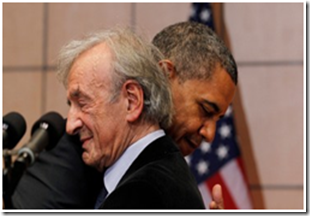 Do we have a stupid President, or what?
Do we have a stupid President, or what?
On Monday, April 23, U.S. President Barack Obama toured the U.S. Holocaust Memorial Museum with Elie Wiesel as his guide. Following the tour, both Wiesel and Obama gave boring, highly hypocritical speeches to the assembled diplomats, Jews, Shoah survivors, supporters and workers. Both speeches together lasted about 35 minutes. (Pictured right, Wiesel and Obama hug between speeches)
During Obama’s talk, he recalled a previous time that Elie had guided him through one of the Shoah’s sacred shrines–Buchenwald, in June 2009. At the 11:10 mark of this video, Obama remembers:
We stopped at an old photo, men and women lying in their bunks, barely more than skeletons, and if you look closely you can see a sixteen year old boy, looking right at the camera, right into your eyes … you can see Elie.
President Obama was talking about this old photo, which is a cropped version of the original.
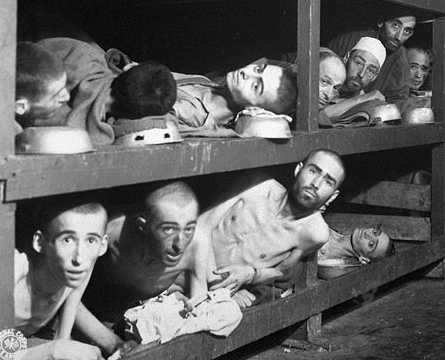 This photograph was taken on April 16, 1945 when Elie Wiesel could not have been in it because he was in the hospital at Buchenwald deathly ill from food poisoning, according to both Night and his memoir All Rivers Run to the Sea.
This photograph was taken on April 16, 1945 when Elie Wiesel could not have been in it because he was in the hospital at Buchenwald deathly ill from food poisoning, according to both Night and his memoir All Rivers Run to the Sea.
Obama made a big boo-boo in saying “men and women” were in the photo, lying in bunks together. But we already questioned his intelligence, so we’ll pass that by. The bigger mistake he made was identifying the face in the far upper right as Elie Wiesel. His presidential aides should familiarize themselves with this blog before their boss’ next meeting with the Holo idol. This site has proven that it is not Elie Wiesel in that picture, especially here and here.
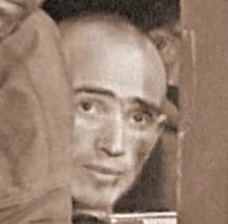 Judge for yourself from this cleaned up, unretouched enlargement of the round-headed man (right), found to be in his 30’s by a computer program designed by Apple. Or check out Computer program judges “Elie Wiesel in Buchenwald” to be 30-36 years of age once again.
Judge for yourself from this cleaned up, unretouched enlargement of the round-headed man (right), found to be in his 30’s by a computer program designed by Apple. Or check out Computer program judges “Elie Wiesel in Buchenwald” to be 30-36 years of age once again.
Compare this face to a real 16 year-old—Nikolaus Grüner in the far lower left of the picture above.
This tells us that President Obama doesn’t think for himself, but accepts whatever he is told by members of the Jewish race, like Elie Wiesel. But we already knew that. Elie says, “That’s me,” and Barack says, “My, so it is.”
Obama continues recalling the Buchenwald meeting:
And at the end of our visit that day, Elie spoke of his father. “I thought one day I would come back and speak to him,” he said “of times of which memory has become a sacred duty of all people of good will. ” Elie, you’ve devoted your life to upholding that sacred duty. You’ve challenged us all as individuals and as nations to do the same with the power of your example, the eloquence of your words … as you did again just now … and so to you and Marion we are extraordinarily grateful.
First, who is we? The entire U.S. citizenry? I’m sure there are many who, like me, opt out of that sentiment and are not grateful to Elie Wiesel. Think how Wiesel uses the word “memory” here. “Memory should become a “sacred duty of all people,” is what he is saying. How can “memory” alone be a sacred duty? But he is meaning a specific memory of the Jewish Holocaust, nothing else. He doesn’t want to say that out loud for all us non-Jews to hear, but we’re supposed to pick it up anyway. We know he means only the memory of the Jewish “holocaust” because he supports the Holocaust Lobby’s condemnation of the Germans’ right to their memories, doesn’t he? If any nation’s memories conflict with the sacred Shoah narrative, they should be suppressed, even criminalized. Wiesel said as much in his speech. In the case of Germany, their non-shoah-approved memories are criminalized (see here). It is the same in Austria and to a lesser degree in many European countries, and Wiesel is on record for favoring criminalization in the United States! Barack Obama is promising that “as a nation” we will follow Elie Wiesel’s example.
You should also be aware that the Shoah narrative is still in flux, still changing, so we don’t even know what we’re in for.
Barack Obama, representing the American people, is committing a great injustice to most of us in order to beg for the Jewish vote. How far will we allow the Jewish takeover of America to go?
UPDATE: April 26, 8 p.m.
A perfect example of the hypocrisy of Wiesel’s “sacred duty of memory” was offered today in a news story from Europe. The U.S. State Department’s “special envoy to fight global antisemitism” Hanna Rosenthal was touring Latvia after meeting earlier with the mayor of Malmo, Sweden. In Latvia, she pressed the Latvian leadership on their country’s continued commemorations of Latvian participation in the Waffen SS, the military wing of the National Socialist party, which included volunteer divisions from all over Europe. Many Latvians consider the volunteers who fought against the Soviets to be heroes of the nation. To Rosenthal’s objections that this amounted to condoning the killing of Jews, they said their history is “complicated” and they don’t see it in simple right/wrong terms. But Rosenthal insisted, with the weight and power of the United States government behind her, that such a commemoration was “offensive to Jews.” Because it is offensive to Jews, the Latvians’ sacred duty to their memory of resisting the takeover by the Soviet Union cannot be allowed.
What could show more clearly that it is indeed only the memories sacred to the Jews that all the world is expected to honor. Our own sacred memories, whatever they may be, must come second to theirs. Who in their right mind accepts such rules?
8 Comments
Category Featured | Tags: Tags: Barack Obama, Buchenwald, Elie Wiesel, USHMM,
Social Networks: Facebook, Twitter, Google Bookmarks, del.icio.us, StumbleUpon, Digg, Reddit, Posterous.
Tuesday, December 6th, 2011
by Carolyn Yeager
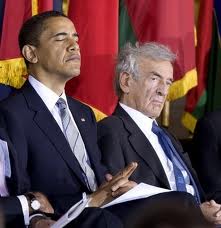 Why do we have a United States Holocaust Memorial Council, anyway?
Why do we have a United States Holocaust Memorial Council, anyway?
This story may seem “old news” as I didn’t get around to posting it when I first saw it. The appointments by the White House took place on Oct. 29. It is still important news, though, as a way of explaining just what is the US Holocaust Memorial Council. I did not know, and knowing what it is helps us to realize just how big an investment the U.S. Government has made in keeping “the Holocaust” alive and kicking in the minds of Americans and foreign visitors to Washington, DC. So here goes …
The United States Holocaust Memorial Council is the governing body of the United States Holocaust Memorial Museum. Did you know that the USHMM, as it’s known, is a project of the U.S. Government? That’s important to know. The Council alone consists of 55 presidential appointees, in addition to ten Congressional representatives and three ex-officio members from the Departments of Education, Interior, and State. That adds up to 68 high-level persons who all get paid by the taxpayers, in one way or another, for “serving” on this Council.
Of the five new Council members, four are Jews. Not only Jews, but they are very active in “holocaust” promotion and other causes solely for Jews. The first is Wiesel, who I think has been a member from the beginning, as he was its Founding Chairman in 1980, appointed by Democrat Jimmy Carter. At that time, Wiesel attempted to sell the idea by writing to Carter that Holocaust activists aim to use the commission (set up to create the museum) to “reach and transform as many human beings as possible. We hope to share our conviction that when war and genocide unleash hatred against any one people or peoples, all are ultimately engulfed in the fire.” Of course, this is never applied to Israel, or even the U.S., which proves the hypocrisy of the “remembrance” campaigns of the Jews. The other appointees are:
Joseph D. Gutman, who is on the executive committee of Birthright Israel and has held leadership roles with the Jewish Federation of Metropolitan Chicago and the Israel Public Affairs Committee (AIPAC).
Roman R. Kent, born in Lodz, Poland (so we know his name is not really Kent) and serves as Chairman of the American Gathering of Jewish Holocaust Survivors and Their Descendants, is President of the Jewish Foundation for the Righteous and of the International Auschwitz Committee, and is Treasurer of the Conference on Jewish Material Claims Against Germany.
Howard D. Unger, an investment banker, the son of a Holocaust survivor, a member of the Committee on Conscience — the Museum’s genocide prevention initiative, and serves on the board of the Holocaust and Human Rights Education Center.
Clemantine Wamariya, a friend of Elie Wiesel, who “survived” the 1994 genocide in Rwanda and now lives in Kenilworth, IL (a very upscale suburb of Chicago). She began speaking about her experiences on the Oprah Winfrey Show in 2005 and has shared her story at Museum events around the country. Currently an undergraduate at Yale University, she is involved in the Yale Refugee Project, which works closely with New Haven’s Integrated Refugee and Immigrant Services.
It’s apparent that each of these persons has a personal investment in keeping holocaust propaganda in the news and appearing timely. They are not objective and don’t balance each other out. However, President Obama said of his appointments: “These fine public servants bring both a depth of experience and tremendous dedication to their new roles […] Our nation will be well-served by these men and women, and I look forward to working with them in the months and years to come.”
U.S. Holocaust Museum and Memorial Council are overwhelmingly Jewish operations
Some of the other newer members of the Council, appointed in June, are Nancy B. Gilbert (Jewish activist), Deborah E. Lipstadt (Jewish activist & author) and Marc R. Stanley (Jewish activist). Members of Congress who serve on the Council are Gabriele Gifford (Jewish, AZ), Patrick Grimm (RC, NY and Brooklyn-born), Nan Hayworth (NY), Pat Meehan (RC, PA), Henry Waxman (Jewish, CA). From the Senate: Richard Durbin (RC, IL); Orrin Hatch (Mormon, UT); Frank R. Lautenberg (NJ) and Bernard Sanders (VT), both Jewish. I’m sure they all get stipends for this “service,” or at the very least “expenses” with no questions asked.
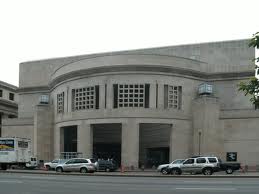 To see a list of the current members of the Council, which appears to be entirely Jewish (though I suppose a few are not), go here: http://www.ushmm.org/museum/council/
To see a list of the current members of the Council, which appears to be entirely Jewish (though I suppose a few are not), go here: http://www.ushmm.org/museum/council/
In addition to this is the large staff of the Holocaust Memorial Museum itself, for which the Federal government donated the land and the U.S. Congress voted unanimously to establish in 1980 after concerted lobbying by American Jews with Israeli backing. Jewish groups came up with a large amount of original funding for the museum, but now American taxpayers provide the bulk of the Holocaust Museum’s annual budget – in 2003 to the tune of $38.4 million which was 67% at the time. Its government funding for fiscal year 2004 was increased to $39,997,000. It is currently in the area of $50 million a year. (By comparison, in 2003, the John F. Kennedy Center for the Performing Arts received less than $34 million in federal funding. That figure was cut to $32,560,000 for fiscal year 2004.)1
Moreover, in the year 2000, President Bill Clinton, a Democrat, signed legislation granting the museum permanent status as a federal agency, in effect locking in federal support. As a museum press release explained at the time, “Permanent status permits Congress to provide funding without having to review the federal role. Every U.S. government entity requires congressional authority before funds can be allocated; but not every federal institution is given permanent status.”
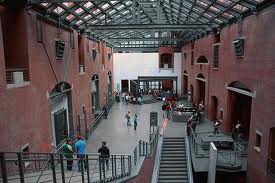 According to the USHMM website, the museum’s function is to be a “living memorial to the Holocaust.” The U.S. taxpayers were not asked whether they thought their tax money should go to providing in perpetuity a living memorial to “The Holocaust” on American soil, but their Congressmen-and-women answered the demand of the Jews to do it in their name.
According to the USHMM website, the museum’s function is to be a “living memorial to the Holocaust.” The U.S. taxpayers were not asked whether they thought their tax money should go to providing in perpetuity a living memorial to “The Holocaust” on American soil, but their Congressmen-and-women answered the demand of the Jews to do it in their name.
Constant media propaganda deceives many an American into thinking this expensive memorial is helping world peace or global humanitarianism. According to an ADL (Anti-Defamation League) press release, the program “brings law enforcement officers to the U.S. Holocaust Memorial Museum in Washington, D.C. for an intensive program that challenges them to examine their relationship with the public and to explore issues of personal responsiblity and ethical conduct.”2 If the museum helps foot the bill for these junkets, that would explain where some of the yearly $50 million goes. In what way, however, does it help U.S. law enforcement officers do a better job enforcing U.S. law, except to “profile” certain groups as likely victims and others as likely perpetrators? It appears to be nothing more than indoctrination. The same is done with school children who are also brought to the museum to be indoctrinated into who are the victims and who the perpetrators.
Who is taking advantage of whom?
This is just one piece of the morality tale of how our government gets stolen out from under us by clever, well-organized Jews and elected representatives of the people who, instead of serving the majority interests, serve Jewish interests. Elie Wiesel has been a ‘friend’ of every U.S. President since he became a U.S. citizen in 1963 … why? There are other ‘holocaust survivors’ among the U.S. population, some with far better stories than Wiesel’s. Many have even written books. Why aren’t they feted by Presidents and put in charge of multi-million dollar budgets and taxpayer-funded museums? Why is it always Wiesel?
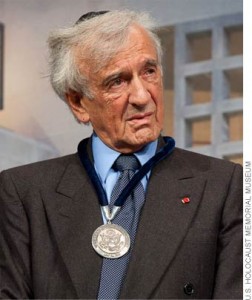 One thing we can say is that a large part of the USHMM’s mission is to facilitate and secure a glorious legacy for Elie Wiesel. He is the chosen one to represent, as much as is possible in the person of one man, the horror and meaning and continuation of the Jewish Shoah for all time. Thus, the USHMM devotes a lot of attention to Wiesel now, and after he is dead … well, you ain’t seen nuthin’ yet. Here, as an example, is what was said upon bestowing on Wiesel the museum’s highest honor in May of this year, which they even named after him:
One thing we can say is that a large part of the USHMM’s mission is to facilitate and secure a glorious legacy for Elie Wiesel. He is the chosen one to represent, as much as is possible in the person of one man, the horror and meaning and continuation of the Jewish Shoah for all time. Thus, the USHMM devotes a lot of attention to Wiesel now, and after he is dead … well, you ain’t seen nuthin’ yet. Here, as an example, is what was said upon bestowing on Wiesel the museum’s highest honor in May of this year, which they even named after him:
In honor of Wiesel’s extraordinary vision and moral stature, which not only created the Museum but inspired a worldwide movement of Holocaust remembrance and education, the award henceforth will be named the United States Holocaust Memorial Museum Elie Wiesel Award.
As a speaker at this event, Clemantine Wamariya (mentioned above as one of the October appointees to the Holocaust Council), said of the impact Wiesel’s book Night had on her as an 8th grade student, “It was as if my mouth opened and I’ve never been quiet since. It spoke to me directly and told me I must not be silent.”
Above: “Saint Elie of Wiesel”
Elie Wiesel the public personage cannot be separated from the U.S. Holocaust Memorial Museum in Washington D.C. It is as responsible for him as he is responsible for it. What that means will continue to be explored on this website.
Endnotes
8 Comments
Category Featured | Tags: Tags: Elie Wiesel, President Obama, U.S. Holocaust Memorial Council, USHMM,
Social Networks: Facebook, Twitter, Google Bookmarks, del.icio.us, StumbleUpon, Digg, Reddit, Posterous.
Monday, September 12th, 2011
By Carolyn Yeager
Proof that the man in the famous Buchenwald photograph is NOT Elie Wiesel.
With the help of the New York Times and the U.S. Holocaust Memorial Museum, Elie Wiesel and his backers did not shy away from criminal deceit by purposely misidentifying an unknown face in this famous photo as belonging to Elie Wiesel.

The above high-resolution photograph of Buchenwald survivors was first published in the New York Times on May 6, 1945 with the caption “Crowded Bunks in the Prison Camp at Buchenwald”. [click on image twice to enlarge fully] It was taken inside Block #56 by Private H. Miller of the Civil Affairs Branch of the U.S. Army Signal Corps on April 16, 1945, five days after the Buchenwald camp was liberated by a division of the US Third Army on April 11, 1945. None of the men in the picture were identified at that time.
The U.S. Army photographer was in block #56, not #66
The U.S. Army photographer said he was inside Block #56. The “children’s block” that housed the so-called “boys of Buchenwald” was #66. This was not a typo. Note that these men are not children or teenagers, except for the youngster on the lower left who has been correctly identified as 16 yr. old Myklos (Nikolaus) Grüner, and maybe a couple others. These adults appear to be a mixture of sick individuals suffering from a wasting disease (Grüner learned after liberation he had TB), along with basically healthy men who were also in that block, for some unknown reason, five days after they had been freed. As we have read from many Buchenwald inmates, they moved about at will from the day of liberation onward. In Elie Wiesel’s book Night, he even says that some of the boys in his block went to the city of Weimar the very next day to steal potatoes and rape girls.
The true facts of this photograph have never been told and perhaps are not known. (Grüner has written in Stolen Identity that he left a procession of youths being led to the camp entrance on the morning of April 11, scurried into the nearest barracks and jumped into an empty bunk space. It turned out to be this one.) But because of the man standing there stark naked except for a piece of clothing held in his hands to cover himself, this photograph was certainly staged. In any event, it was never represented as the “children’s barracks.” Still, Elie Wiesel inexplicably once told an interviewer for the German weekly Die Zeit that this photograph was taken in the Children’s Block and all these men were really teenagers even though they looked old. (Source: “1945 und Heute: Holocaust,” Die Zeit, April 21, 1995.)
Kenneth Waltzer wrote to this website EWCTW on Nov. 14, 2010: “Eli Wiesel was indeed the Lazar Wiesel who was admitted to Buchenwald on January 26, 1945, who was subsequently shifted to block 66…” and Waltzer repeated in another comment on June 27, 2011 that “— after his father died — Elie Wiesel was moved in early February to block 66, the kinderblock. Miklos Gruner too was in block 66. Elie Wiesel was there with other boys from Sighet, who knew him.”
But we are also to accept that on April 16 Wiesel was in block 56, even though he didn’t report any such move in his book Night. In fact, in that fictitious story, Wiesel says he became deathly ill with food poisoning three days after liberation (April 14) and spent the next two weeks in hospital (pg 115, Marion Wiesel translation). That in itself precludes his being in this photograph taken on April 16!
Whom do you believe—the New York Times or your own eyes?

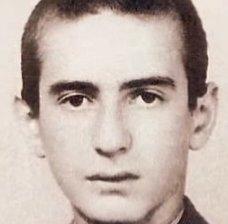 Not Wiesel at age 16 in 1945
Not Wiesel at age 16 in 1945
You can see for yourself from these two high-quality photographs supplied to me by a helpful reader that the face on the left is not Wiesel. A close inspection of the prisoners in the bunks in the famous photograph reveals that the eyebrows on many (including the one on the left above) were emphasized with a dark crayon/pencil … in other words, retouched or “photo-shopped.” On the right is what is claimed to be Elie Wiesel in 1944 at the age of 15.
The inmate on the left definitely has an aquiline nose and full, even sensual, lips. In this close-up, the receding hairline is visible on the recently shaved head. On the right, the real 15-year-old Elie Wiesel exhibits a normal youthful hairline, a bigger and longer nose and thinner lips. He also has a higher forehead and longer face than the more roundish-headed inmate. The eyes of the man on the left are not as deep-set under the eyebrows. His somewhat surprised, curious expression is not typical of Wiesel, whose expression was generally reserved, and often hooded.
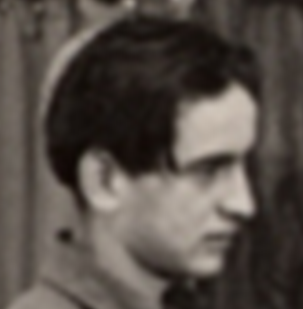
The close-up on the left appears to be the real Elie Wiesel in France later in 1945. He would be 17 or almost 17 years old in this picture. Notice the non-receding, youthful hairline with a very long front lock hanging to the side, and the straight nose .
This close-up image is from the photograph below, which is found at the USHMM Survivor Resource Center with the caption given below. (click here or on lower pic for an undistorted, larger image)
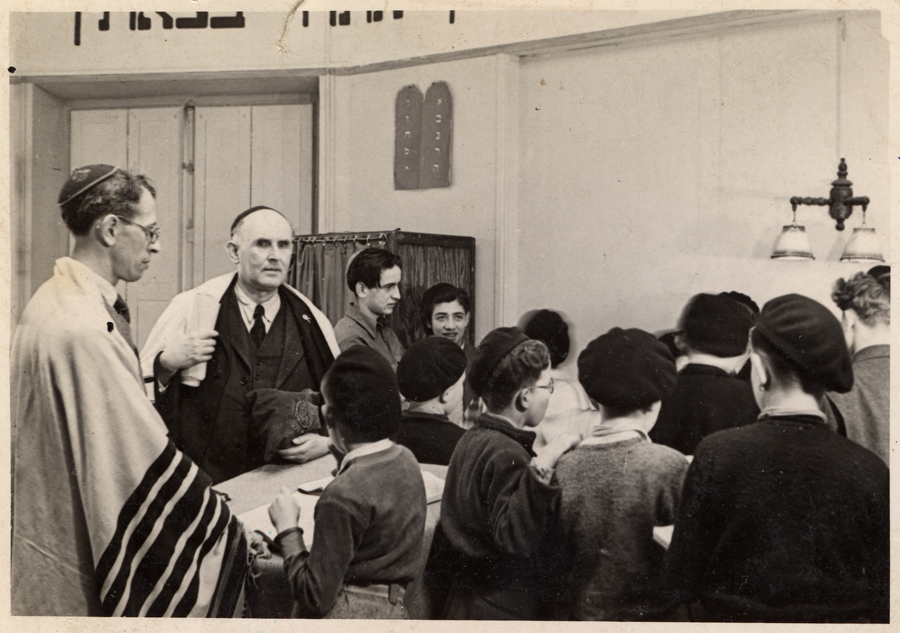
Above, Jewish boys gather for a prayer service in a chapel in an OSE children’s home in 1945. Those pictured include Elie Wiesel (seen in profile) and Jakob Rybsztajn standing next to him facing the camera. (I note that Elie Wiesel is older than the other boys in this picture, giving support to the idea that he acted in the role of counselor and sometime teacher to the newer, younger religious boys.)
Notice again the straight nose, the high forehead, deep-set eyes, large ears, sensitive mouth and slender neck. But also look at all that hair! The date of this picture is given by USHMM as 1945 and the location as Ambloy, [Loir et Cher] France. It says in the accompanying text “In October 1945 the children and staff of Ambloy were relocated to the Chateau de Vaucelles in Taverny (Val d’Oise).” That means this picture was taken between June and October 1945. They could have been celebrating Rosh Hashana, Yom Kippur or Sukkot.
But could his hair have grown to such a length from a shaved head in April 1945? No way, and thus we have another proof that the liberated Buchenwald inmate with the shaved head is NOT Elie Wiesel.
A PDF from my valued contributer examines the ages of the small group more closely. In my opinion, he has the ages of all four men a little too young but especially #2 and 4. Take a look: four men in bunk
Who first identified Elie Wiesel in the famous Buchenwald liberation photo?
In October 1983 the Jewish-owned New York Times published this photograph as part of an article in its high circulation Sunday NYT Magazine with the caption: “On April 11, 1945, American troops liberated the concentration camp’s survivors, including Elie, who later identified himself as the man circled in the photo.”
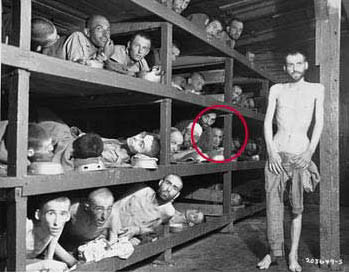
It was also in 1983 that Wiesel’s friend Sigmund Strochlitz began campaigning for a Nobel prize for Wiesel. Letters of nomination are due into the Nobel committee by Feb.1 of each year, so by January 1984, the committee was receiving letters nominating Wiesel from U.S. Senators such as Daniel Moynihan and Barry Goldwater (both Jewish). [see “How Elie Wiesel Got the Nobel Peace Prize“] The effort continued, with new and ever more innovative ideas, through 1985 and 1986 with the help of Jew John Silber, President of Boston University, Wiesel’s employer. Hundreds were enlisted into the effort.
The 1983 article in the New York Times that was the opening gun of the campaign was written by Jew Samuel Freedman and titled “Bearing Witness: The Life and Work of Elie Wiesel.” It included this line: “His name has been frequently mentioned as a possible recipient of a Nobel Prize, for either peace or literature.” Well, it had just begun to be mentioned … by this team of cheerleaders.
Wiesel pretends that he had nothing to do with it. In an interview in France in 2009, he said: “If you fight or if you do scientific research to get the Nobel, you never succeed and you should not succeed.” (Elie Wiesel, “messager de la memoire”) No, he did not fight but his mercenaries fought for him, and he used this photograph as his “research.” That this photograph played a large role is shown by the fact that immediately after the Nobel award ceremony in December 1986, Wiesel went to Yad Vashem Memorial in Jerusalem and posed in front of its prominent display there.

Elie Wiesel on Dec. 18, 1986 at Yad Vashem in Jerusalem
After the award was announced by the Nobel Committee, the New York Times published on Nov. 1 a severely cropped version of the Buchenwald photo (below) with the caption: “Elie Wiesel, the winner of the Nobel Peace Prize (at far right in the top bunk) in the Buchenwald concentration camp in April 1945, when the camp was liberated by American troops.” The picture accompanied an article by Jew Martin Susskind titled, “A Voice from Bonn: History Cannot Be Shrugged Off.”

The role played by the tax-payer funded United States Holocaust Memorial Museum
Elie Wiesel finagled his way to becoming Founding Chairman of the United States Holocaust Memorial Council in 1980 after being chosen in 1978 by President Jimmy Carter as chairman of the President’s Commission on the Holocaust. Why the United States needed to do anything at all about the “Holocaust” is something only the 2.5% Jewish population in this country can answer. It is to satisfy them. Wiesel continued to chair the Council until 1986, when he reached his goal of becoming a Nobel Laureate. The USHMM was undoubtedly an important institutional heavyweight that leveraged him to the Nobel.
The USHMM naturally accepted that Wiesel was in the famous photograph as soon as he and the New York Times said he was. If you think the museum staff does real research, is searching for truth and/or is engaged in scholarship of any kind, you are badly mistaken. The museum represents official power only and is invested in keeping it in Jewish hands.
This photograph is the only document tying Elie Wiesel to the Holocaust
The only document that connects Elie Wiesel to the Auschwitz-Birkenau and Buchenwald experience he claims to have—in other words, his claim to be an authentic “Holocaust survivor”—is the famous Buchenwald liberation photograph. There are no records with his name and birth date for either camp. His books do not support his presence there very well. That’s why the Wiesel promoters, who wanted to anchor their man’s claim to be the unchallenged spokesman for the world’s greatest victims—which winning a Nobel prize would surely do—decided that they could pawn that unknown face off as the face of Wiesel. This decision was made in 1983. It’s certain that Elie Wiesel took part in making it, though the pretense is kept up by all that he was aloof from the entire process.
What you must do
When you comprehend the immense power that this simple photo comparison and commentary gives us, you know that we have it in our hands to break down the Wiesel legend if this knowledge is widely circulated. If you understand this, you know what you must do. You must post this article everywhere you can, you must tell everyone about it, send it to all you know … make sure that this photo comparison moves through the Internet and finds a home in as many places as possible. And keep it up, because once is not enough. I’ve done my part, readers. Now it’s up to you.
54 Comments
Category Featured | Tags: Tags: Ambloy France, Block 66, boys of Buchenwald, Buchenwald liberation, Elie Wiesel, Holocaust fraud, Ken Waltzer, Myklos Gruener, New York Times, Nobel Peace Prize, OSE, US Holocaust Memorial Museum, USHMM,
Social Networks: Facebook, Twitter, Google Bookmarks, del.icio.us, StumbleUpon, Digg, Reddit, Posterous.
Tuesday, July 12th, 2011
By Carolyn Yeager
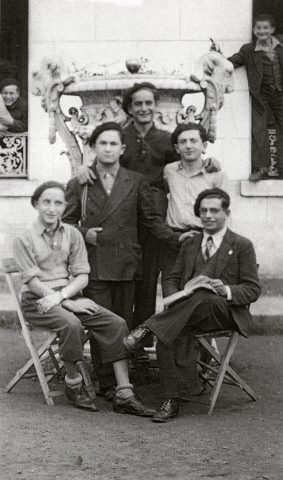
Pictured: front left, Kalman Kalikstein; Binem Wrzonski (middle right), and Elie Wiesel (back center).
This picture is now available for purchase at the USHMM website. The information about it is given as follows:
Date: 1945-1946
Locale: Ambloy (Loir-et-Cher) France
Credit: United States Holocaust Memorial Museum, courtesy of Binem Wrzonski
Copyright: United States Holocaust Memorial Museum
Title: Group portrait of boys in the Ambloy children’s home.
USHMM Commentary: In June 5, 1945, Binem joined a group of boys and young teenagers, known as “The Buchenwald Boys” who were brought to France in a special convey under the sponsorship of the O.S.E. They first were brought to Ecouis in Normandy. An aid worked (sic) helped Binem to make contact with his one surviving sibling, Towa who had spent the war in the Soviet Union. From Ecouis the children were taken to either secular or religious homes. Binem at first wanted to go to a secular home, but Leo Margolis, a German Jew who was in Buchenwald for approximately six years and helped care for the children, persuaded him to go to a religious home. Binem then went to Chateau d’Ambloy. From there he went to Taverny. Then together with two other teenagers, with Elie Wiesel and Kalman Kaliksztajn, he accompanied a group of younger boys to Chez Nous in Versailles where worked as a counselor. From this experience, Binem decided to become a teacher. After training in France, he immigrated to Israel and became the principal of a Youth Aliyah boarding school. In Israel he met and married Rahel Schlezinger and they went on to have five children and many grandchildren and great-grandchildren. In 1983 Binem returned to Lodz and erected a new marker at his father’s graves including the names of all of his family members who died during the Holocaust. [end of USHMM commentary]
* * * *
Binem came from Buchenwald, but not Elie Wiesel and maybe not his good friend Kalman!
What is amazing about this commentary on the picture above is that Elie Wiesel is NOT said to have been at Buchenwald with Binem, but encountered him at Taverny. Elie and Kalman, according to Binem, accompanied a group of younger boys to Chez Nous in Versailles where they worked as counselors. This actually makes a lot more sense. A narrative in which Elie Wiesel is not a withdrawn, scarred youth from the concentration camps, but possibly arrived in France sometime during the war—helped by the Jewish network and placed in the children’s welfare institutions—is quite possible. There, he associated with some of the youths who were sent after the war, and developed his “knowledge” of concentration camp life from them.
Is this why he had no interest in gaining French citizenship—because he was devoted to the Jewish cause of Eretz Israel and always connected to and working with the Jewish Underground? (See Elie Wiesel and the Mossad)
Was Elie Wiesel actually a youth counselor for Buchenwald boys, rather than one of them?
Can this explain why he remained with the welfare agencies for so long and was one of the oldest to leave his last home at Versailles to live on his own? His friend Kalman left for Israel in 1947 before Elie managed to get a room of his own “at the end of summer” at the age of 19. This would have been after his birthday on Sept. 30.
Compare this photograph with the one below, which the USHMM identifies as:
Group portrait of the staff and boys of Ambloy, an OSE home for religious youth.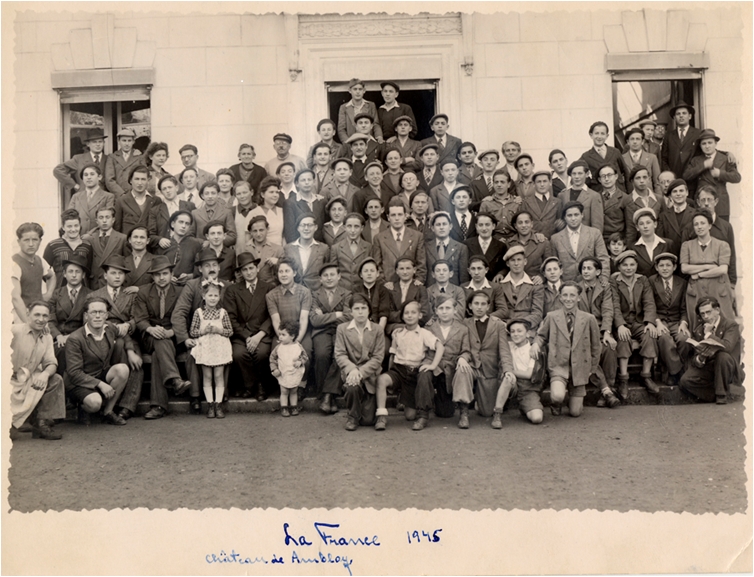
Among those pictured are (First row, left to right): Natan Szwarc, Izio Rosenman, Deblin, unknown and perhaps Berek Rybsztajn. (Third row): Abraham Tuszynsky (2nd from left, first boy next to woman), Andre Zelig is in the center with a tie and his hands on the boy in front of him and Elie Wiesel (second right of Tuszynsky). Binem Wrzonski is to the right of Elie Wiesel. The donor, Jakob Rybsztajn is in the fourth row, fifth from the left.
This picture is available for purchase from USHMM website. The information given about it is as follows:
Date: 1945
Locale: Ambloy, (Loir-et-Cher) France
Credit: United States Holocaust Memorial Museum, courtesy of Jacques Ribons
Copyright: United States Holocaust Memorial Museum
The inscription on the back reads “Before our departure from Chateau Ambloy for Paris.”
USHMM Commentary: Jakob Rybsztajn (now Jacques Ribons) is the son of Peretz Rybsztajn (b. 1905) and Bella (Bajal, b. 1906) Rybsztajn. He was born on August 15, 1927 in Strzemieszyce Poland where his father was a textile manufacturer. He had two younger siblings: Bernard (Berek) who was born in 1929 and Esther who was born in 1935. In 1933 the family moved to Zelow, Bella’s home town. The family remained there until 1936 when it moved back to Strzemieszyce. In 1939 Germany invaded Poland later the Rybsztajns were forced to move to a ghetto. Jakob attended a ghetto Hebrew school. Peretz Rybsztajn, his father, worked with or was close with the Jewish Council but he soon disappeared. After the ghetto was liquidated, probably in June 1943, Jakob and Berek, who initially had hid, were forced to return and then sent briefly to Bedzin. In September they were deported to the Blechhammer concentration camp where they were forced to work unloading cement from train cars, insulating oil and fuel tanks with asbestos, and cementing steel forms to the tanks. They lived in a barrack with other boys their ages, including Kalman and Heniek Kaliksztajn, two brothers also from Strzemieszyce. In January 1945 the Germans liquidated the camp in advance of the Soviet army, and the brothers were sent on a death march via Gross Rosen and by open train to Buchenwald. They arrived in Buchenwald on February 10, 1945, and were placed in the children’s block, Block 66.
Jakob and Berek remained together in block 66 until they were liberated in Buchenwald by the U.S. Third Army in April. The boys in the barrack, under the supervision of Gustav Schiller, the deputy block elder, did not work and received occasional Red Cross packages distributed from other prisoners in the camp. After liberation, the Rybsztajn brothers joined a children’s transport to Ecouis in France, sponsored by the O.S.E., where they were through the summer. But, as they were religious, they were sent from there with other religious boys, including the Kaliksztajn brothers, also Elie Wiesel, to children’s homes in Ambloy and Taverny. Then Jacques came to Paterson New Jersey and later enlisted in US army during the Korean conflict. He arrived in New York in February 1947 on board the Gripsholn, a Swedish ship. Berek was adopted by the Homberger family in California. Later he was in Israel and served in the Israeli Defense Forces; he returned to California in the late 1950s. Jacques also settled in Los Angeles. The Rybsztajn parents, Perez and Bella Rybsztajn, and their sister younger sister Esther perished in Auschwitz, it is believed, during 1943. [end of USHMM commentary]
* * * *
If it can be proven that this is indeed Elie Wiesel in the two pictures, we still do not know if he arrived in Ambloy from Buchenwald.
We have learned that others were there already and the Buchenwald boys joined them. He may have been one of those who were already there. The commentary states as an afterthought that “also Elie Wiesel” was among those sent to Ambloy and Taverny. Where are the records that must have existed? In what capacity was Elie Wiesel there?
The person identified in each photo above as Elie Wiesel is dressed in the same clothing, so the pictures were most likely taken on the same day. The boy Binem may simply have taken off his jacket in the more casual top picture. But where is Kalman in the large group photo? He is not identified and appears to be missing. Rather than pictures on more than one occasion, we have two different pictures taken at the same time.
The group is dressed for travel to Paris (Versailles). It must have been later than 1945 that they transferred to the home in Versailles, so this picture should probably be dated 1946, as is the top picture. All of these questions I raise show the poor scholarship done by the USHMM and the holocaust historians in general. Slip-shod reporting is picked up from here and there, thrown together, becoming the “story” that fits the bill. Thus we have Elie Wiesel’s name stuck in where they want it to be, to try to show that he was one of the Buchenwald boys, when actual proof doesn’t exist.
These photographs only portray someone who could be Elie Wiesel at a home in Ambloy, France where some of the boys from Buchenwald, and also Jewish boys from elsewhere, lived for a time.
As far as the next picture is concerned, I now cannot be sure that these boys are arriving from Buchenwald. They are only identified as Jewish DP (displaced persons) youth at the USHMM website:
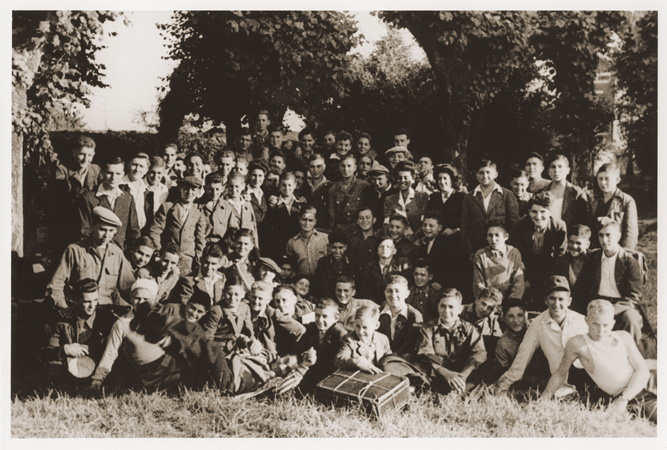
Group portrait of Jewish DP youth at the OSE (Oeuvre de Secours aux Enfants) home for Orthodox Jewish children in Ambloy. Elie Wiesel is among those pictured. [Photograph #28147]
This photo is also available for purchase at USHMM website. The information given about it is as follows:
Date: 1945
Locale: Ambloy, (Loir-et-Cher) France
Credit: United States Holocaust Memorial Museum, courtesy of Robert Waisman. Willy Fogel
Copyright: United States Holocaust Memorial Museum
In this case, none of the boys are identified by name. In the long commentary that accompanies the picture on the page, there is no mention at all of Elie Wiesel. I will say that no one in this picture is wearing a beret! Once again, if the USHMM or Prof. Ken Waltzer claim that Elie Wiesel is in this picture, they must point him out.
It has never been disputed that Elie Wiesel was in France. But just when he arrived and what he was doing there is not documented.
* * * *
The next step for the reader is to compare the face of “Elie Wiesel” in the first two photos above with the faces of “Elie Wiesel” in the famous Buchenwald photo and the boys marching out of the Buchenwald gate, plus his portrait as a 15-year-old, that are found at “The Many Faces of Elie Wiesel.” They can’t all be Elie Wiesel. It’s up to you—and up to USHMM and Ken Waltzer, and how about the old liar Elie Wiesel himself!—to decide and announce which ones are. When that is clear, we can then decide what the pictures are telling us.
10 Comments
Category Featured | Tags: Tags: Ambloy, Binem Wrzonski, Buchenwald, Elie Wiesel, Jacques Ribons, USHMM,
Social Networks: Facebook, Twitter, Google Bookmarks, del.icio.us, StumbleUpon, Digg, Reddit, Posterous.
















































